Samsung Electronics Co SH100 Digital Camera User Manual 2 of 2
Samsung Electronics Co Ltd Digital Camera 2 of 2
Contents
- 1. User manual 1 of 2
- 2. User manual 2 of 2
User manual 2 of 2
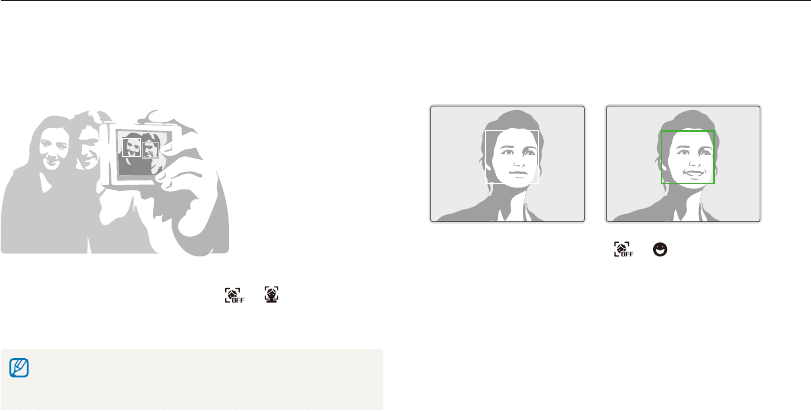
Shooting options
51
Using face detection
Taking a smile shot
The camera automatically releases the shutter when it detects a
smiling face.
In Shooting mode, select f . When your subject
smiles broadly, your camera can detect the smile more easily.
Taking a self portrait shot
Take photos of yourself. The focus distance will be set to close-
up and your camera will emit a beep.
In Shooting mode, select
1
f
.
When you hear a quick beep, press [
2
Shutter].
To turn the beep on or off, select t Self-Portrait in the sound settings.
(p. 108)
If you turn volume off in settings, the camera will not emit a beep.t
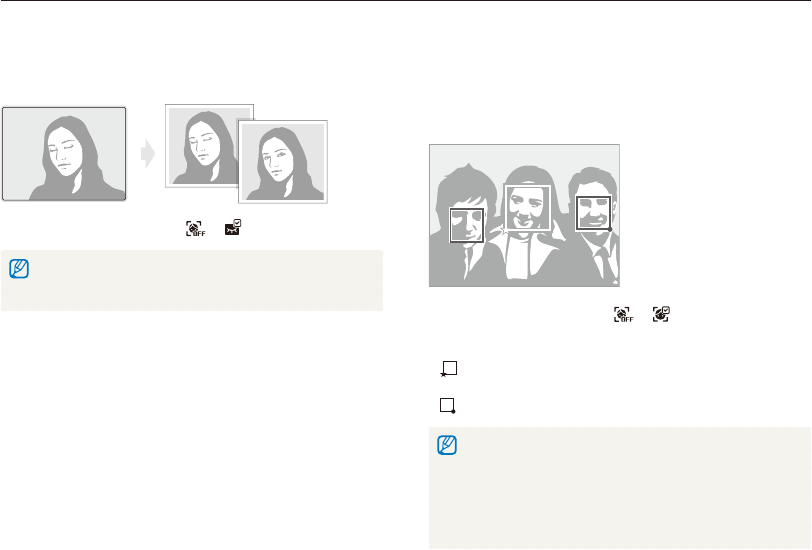
Shooting options
52
Using face detection
Using smart face recognition
The camera automatically registers faces that you frequently
photograph. This feature will automatically prioritize the focus on
those faces and favorite faces. This feature is available only when
you use a memory card.
In Shooting mode, select f . The nearest face
appears in a white focus frame and the rest of the faces appear in
gray focus frames.
t : Indicate favorite faces
(To register favorite faces, see page 53).
t : Indicate faces that the camera automatically registers.
The camera may recognize and register faces incorrectly depending t
on lighting conditions, remarkable changes in the subject's pose or
face, and whether or not the subject is wearing glasses.
The camera can automatically register up to 14 faces. If the camera t
recognizes a new face when there are 14 registered faces, it will
replace the face in the lowest priority with the new one.
The camera can detect up to 5 faces in one scene.t
Detecting eye blinking
If your camera detects closed eyes, it will automatically take 2
photos in succession.
In Shooting mode, select f .
Hold your camera still while “t Capturing” is displayed on the screen.
When blink detection fails, “t Picture taken with eyes closed.”
message appears. Take another photo.
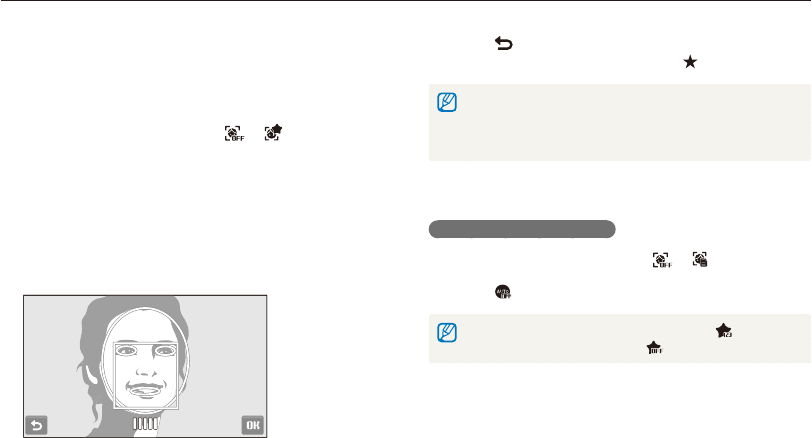
Shooting options
53
Using face detection
Select
3
when the face list appears.
Your favorite faces are indicated with a t on the face list.
You can register up to 6 favorite faces.t
The flash option will be set to t Off.
If you register the same face twice, you can delete one of the faces t
in the face list.
Viewing your favorite faces
In Shooting mode, select
1
f
.
Select
2
to view your favorite faces.
To change the ranking of your favorite faces, select t . (p. 68)
To cancel your favorite faces, select t .
Registering faces as your favorites (My Star)
You can register your favorite faces to prioritize the focus and
exposure on those faces. This feature is available only when you
use a memory card.
In Shooting mode, select
1
f
.
Align your subject’s face with the oval guideline and
2
press [Shutter] to register the face.
If the subject’s face is not aligned with the oval guideline, the t
white frame will not appear.
You will take 5 photos of the subject’s face: one each from the t
front, left, right, above, and below.
Take photos of one person at a time when registering faces.t
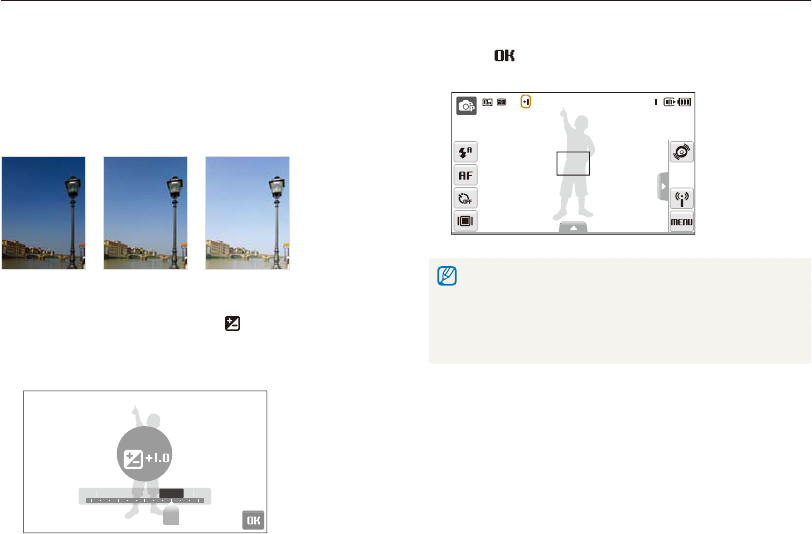
Shooting options
54
Adjusting the exposure manually (EV)
Depending on the intensity of the ambient light, your photos
may be too bright or dark. In these cases, you can adjust the
exposure to get a better photo.
Darker (-) Neutral (0) Brighter (+)
In Shooting mode, select
1
f
.
Select a value to adjust the exposure.
2
+: brighter, -: darkert
-2 -1 0 +2-2 -
1
0
0
+
2+1
EV
pv
Adjusting brightness and color
Learn how to adjust the brightness and color for better image quality.
Select
3
.
The adjusted exposure value will appear as shown below.t
Once you adjust the exposure, the setting will remain the same. You t
may need to change the exposure value later to avoid overexposure
or underexposure.
If you cannot decide on an appropriate exposure, select t AEB (Auto
Exposure Bracket). The camera takes 3 consecutive photos with
different exposures: normal, underexposed, and overexposed. (p. 59)
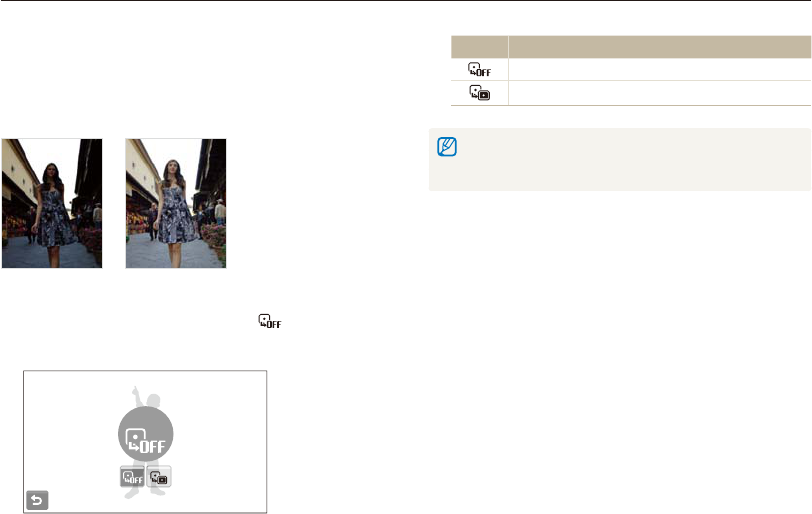
Shooting options
55
Adjusting brightness and color
Option Description
Off: ACB is off.
On: ACB is on.
The ACB feature is always on in t
a
mode.
This feature is not available when t Continuous, Motion Capture, or
AEB is in use.
Compensating for backlighting (ACB)
When the light source is behind your subject or there is high
contrast between your subject and the background, your subject
is likely to appear dark in the photo. In this case, set the Auto
Contrast Balance (ACB) option.
Without ACB With ACB
In Shooting mode, select
1
f
>
.
Select an option.
2
Off
p

Shooting options
56
Adjusting brightness and color
Option Description
Spot:
Your camera measures only the light intensity of the t
very center of the frame.
If a subject is not in the center of the frame, your t
photo may be improperly exposed.
Suitable for a subject with backlighting.t
Center-weighted:
Your camera averages the meter reading of the t
entire frame with emphasis placed on the center.
Suitable for photos with subjects in the center of t
the frame.
Changing the metering option
The metering mode refers to the way in which a camera
measures the quantity of light. The brightness and lighting of your
photos will vary depending on the metering mode you select.
In Shooting mode, select
1
f
.
(In
p
mode, select
f
>
.)
Select an option.
2
Multi
Option Description
Multi:
Your camera divides the frame into several areas, t
and then measures the light intensity of each area.
Suitable for general photos.t
pv
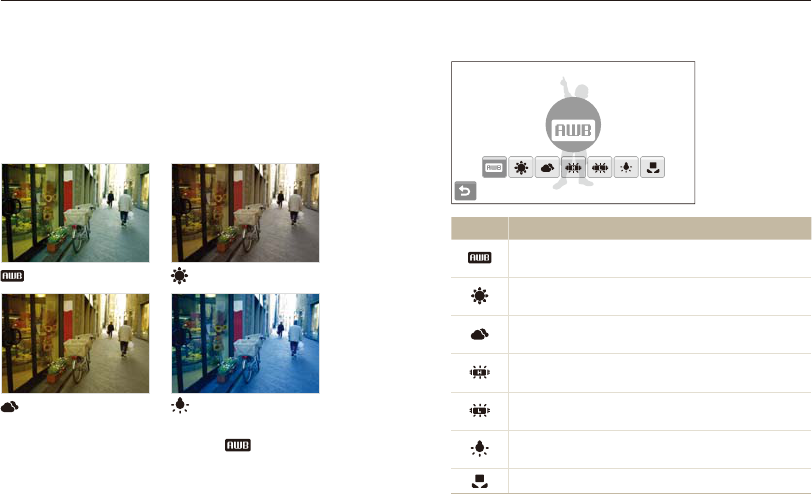
Shooting options
57
Adjusting brightness and color
Select an option.
2
Auto WB
Option Description
Auto WB: Use automatic settings depending on the
lighting conditions.
Daylight: Select when taking outdoor photos on a
sunny day.
Cloudy: Select when taking outdoor photos on a
cloudy day or in shadows.
Fluorescent_H: Select when shooting under a
daylight fluorescent or three-way fluorescent light.
Fluorescent_L: Select when shooting under white
fluorescent light.
Tungsten: Select when taking indoor photos under
incandescent bulbs or halogen lamps.
Custom Set: Use your pre-defined settings. (p. 58)
Selecting a light source (White balance)
The color of your photo depends on the type and quality of the
light source. If you want the color of your photo to be realistic,
select an appropriate lighting condition to calibrate the white
balance, such as Auto WB, Daylight, Cloudy, or Tungsten.
Auto WB Daylight
Cloudy Tungsten
In Shooting mode, select
1
f
.
pv

Shooting options
58
Adjusting brightness and color
Defining your own white balance
You can customize the white balance by taking photos of a white
surface, such as a piece of paper. This will help you to match
the colors in your photo with the actual scene according to your
lighting condition.
In Shooting mode, select
1
f
.
Aim the lens at a piece of white paper.
2
Press [
3
Shutter].
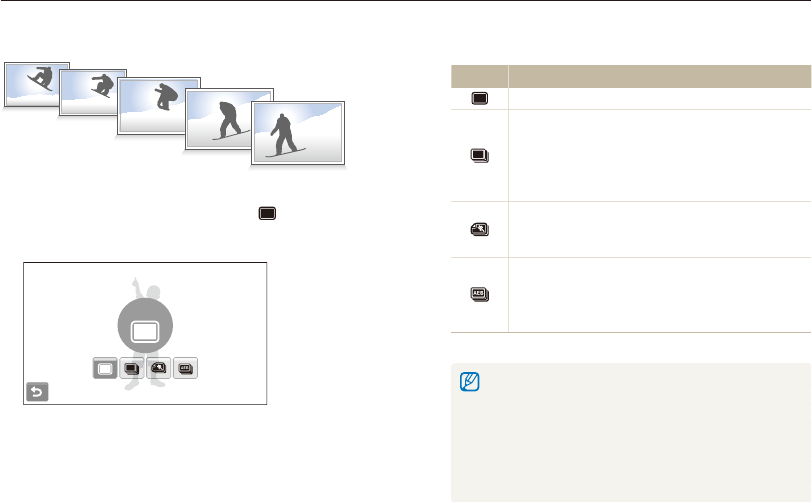
Shooting options
59
Using burst modes
It can be difficult to take photos of fast-moving subjects or capture natural facial expressions and gestures of your subjects in photos.
In these cases, select one of the burst modes.
p
Option Description
Single: Take a single photo.
Continuous:
While you are pressing [t Shutter], the camera takes
photos continuously.
The maximum number of photos depends on the t
capacity of your memory card.
Motion Capture: While you are pressing [Shutter],
the camera takes VGA photos (6 photos per second;
maximum of 30 photos).
AEB:
Take 3 consecutive photos with different exposures: t
normal, underexposed, and overexposed.
Use a tripod to prevent blurry photos.t
The options may differ depending on the shooting mode.
You can use the flash, timer, and ACB only when you select t
Single.
When you select t Motion Capture, the resolution will be set to
VGA and the ISO speed will be set to Auto.
Depending on the selected face detection option, some burst t
options are not available.
You can capture continuous photos if you selectt Children mode
in Scene mode.
In Shooting mode, select
1
f
>
.
Select an option.
2
Single
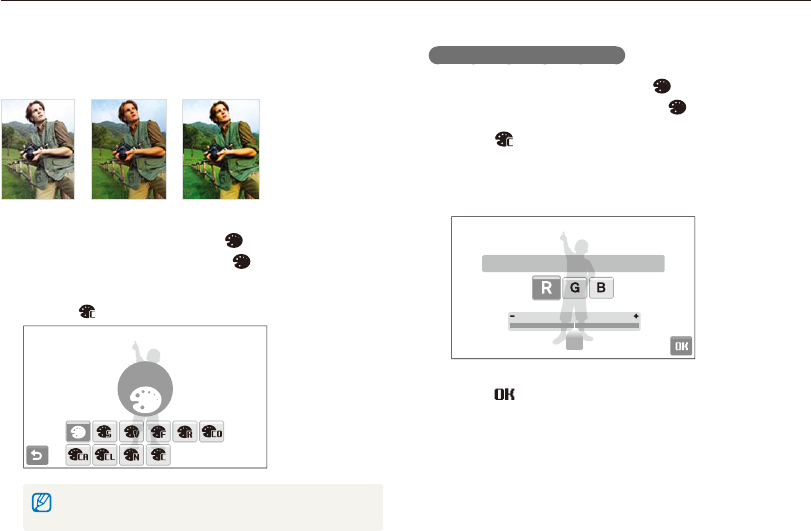
Shooting options
60
Improving your photos
Learn how to improve your photos by applying photo styles, colors, or smart filter effects, or make some adjustments.
Defining your own RGB tone
In Shooting mode, select
1
f
.
(In
p
mode, select
f
>
.)
Select
2
.
Select a color (R: Red, G: Green, B: Blue).
3
Adjust the amount of the selected color.
4
Custom RGB
Select
5
.
Applying photo styles
Apply various styles to your photos, such as Soft, Vivid, or Forest.
Soft Vivid Forest
In Shooting mode, select
1
f
.
(In
p
mode, select
f
>
.)
Select an option.
2
Select t to define your own RGB tone.
Normal
If you use this function, you cannot set the face recognition, smart filter
and image adjustment options.
apv
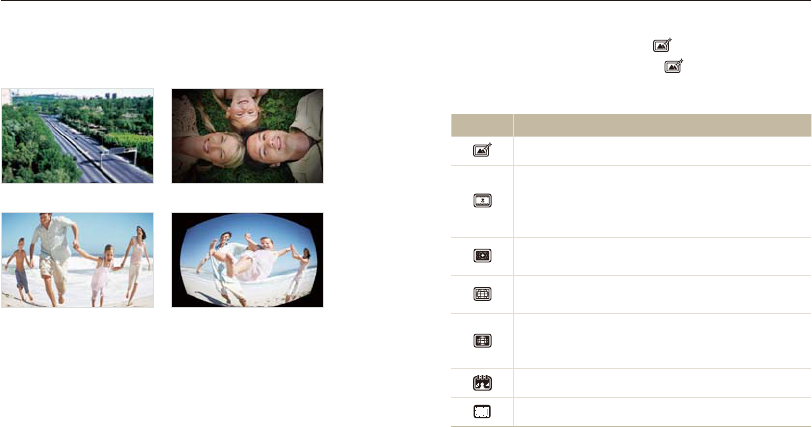
Shooting options
61
Improving your photos
In Shooting mode, select
1
f
.
(In
p
mode, select
f
>
.)
Select an effect.
2
Option Description
Normal: No effect
Miniature: Make a photo of a life-size location or
object look like a photo of a miniature scale model.
Blurring parts of the photo makes the scene seem
much smaller than it actually is.
Vignetting: Apply the retro-looking colors, high
contrast, and strong vignette effect of lomo cameras.
Fish-eye 1: Distort close objects to imitate the visual
effect of a fisheye lens.
Fish-eye 2: Blacken the edges of the frame and
distort objects to imitate the visual effect of a fisheye
lens.
Sketch: Make a photo looks like a drawing.
Defog: Make a photo clearer.
Applying smart filter effects
Apply various filter effects to your photos to create unique images.
Miniature Vignetting
Fish-eye 1 Fish-eye 2
apv
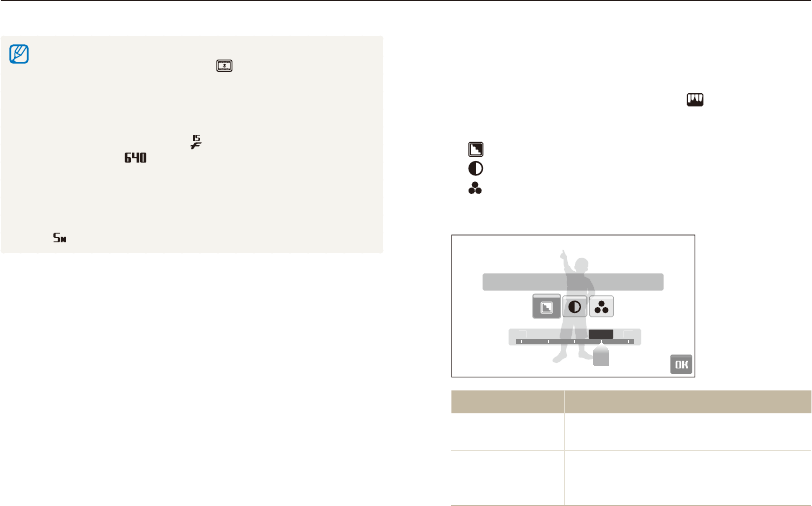
Shooting options
62
Improving your photos
Adjusting your photos
Adjust the sharpness, saturation, and contrast of your photos.
In Shooting mode, select
1
f
>
.
Select an adjustment option.
2
t : Sharpness
t : Contrast
t : Saturation
Select a value to adjust the selected item.
3
-2 -1 +2
-
2
-1
+
2+10
Sharpness
Sharpness option Description
-Soften the edges on your photos (suitable
for editing the photos on your computer).
+
Sharpen the edges to improve the clarity
of your photos. This may also increase the
noise on your photos.
p
If you select t Miniature when recording a video, the miniature
recording time is displayed with the icon and is shorter than the
real recording time.
If you select t Miniature when recording a video, the sound will not
be recorded.
When you apply a smart filter effect while recording a video, the t
recording speed will be set to and the recording resolution will be
set to less than .
If you use this function, you cannot set the photo style and image t
adjustment options.
The options may differ depending on the shooting mode.t
When you select t Sketch, the photo will be automatically resized to
or smaller.

Shooting options
63
Improving your photos
Contrast option Description
-Decrease the color and brightness.
+Increase the color and brightness.
Saturation option Description
-Decrease the saturation.
+Increase the saturation.
Select t 0 if you do not want to apply any effects (suitable for printing).
If you use this function, you cannot set the face recognition, photo t
style and smart filter options.

Playing back
………………………………… 65
Starting Playback mode
……………………… 65
Playing a video
……………………………… 73
Playing a voice memo
……………………… 74
Editing a photo
……………………………… 76
Rotating a photo
…………………………… 76
Resizing photos
……………………………… 76
Using Smart crop
…………………………… 77
Applying photo styles
………………………… 77
Applying smart filter effects
………………… 78
Applying a special effect
……………………… 79
Adjusting photo
……………………………… 80
Creating a print order (DPOF)
………………… 80
Viewing files on a TV
……………………… 82
Transferring files to your computer
(for Windows)
……………………………… 83
Transferring files using Intelli-studio
………… 84
Transferring files by connecting the camera
as a removable disk
………………………… 86
Disconnecting the camera (for Windows XP)
87
Transferring files to your computer
(for Mac)
…………………………………… 88
Printing photos with a photo printer
(PictBridge)
………………………………… 89
Playback/Editing
Learn how to play back photos, videos, or voice memos and edit photos or videos. Also, learn how to
connect your camera to your computer, photo printer or TV.
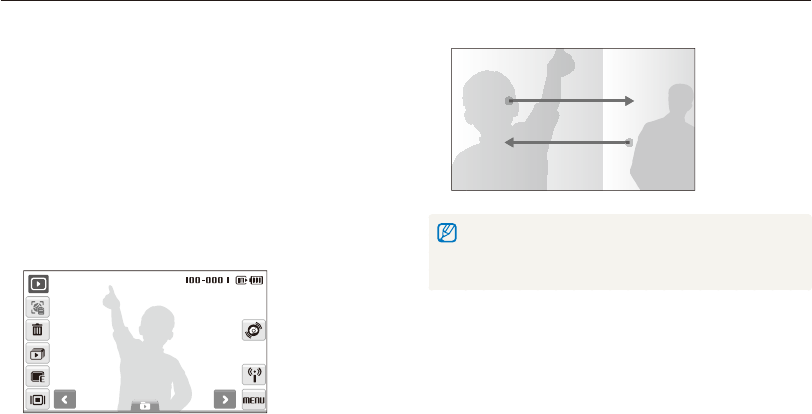
Playback/Editing
65
Playing back
Learn actions to play back photos, videos, or voice memos, and managing files.
If you want to view files stored in the internal memory, remove your t
memory card.
The camera will not properly play back files that are too large or those t
taken with cameras from other manufacturers.
Starting Playback mode
View photos or play videos and voice memos stored in your
camera.
Press [
1
Playback].
The most recent file you have taken or recorded will be t
displayed.
If the camera is off, it will turn on.t
Drag files left or right to scroll through files.
2
Select t
<
to view the previous file. Hold to view files quickly.
Select t
>
to view the next file. Hold to view files quickly.

Playback/Editing
66
Playing back
Selecting a menu using motion recognition
Your camera features a built-in motion sensor that allows you to
quickly select a menu by tilting the camera.
In Playback mode, tilt the camera while touching and
holding .
* You cannot set files as favorites for:
videos or voice memos -
photos with errors or locked photos -
photos taken with cameras from other manufacturers -
photos taken using the motion capture option set -
photos that are too large for the available memory -
Viewing files using motion recognition
You can view files by tilting the camera.
Motion recognition may not work well if you hold the camera t
parallel to the ground.
When you rotate the camera 90t o or 180o while viewing a photo,
the camera will automatically change the orientation of the
displayed photo according to the camera direction.
To deactivate this function, select t M . Gesture View
Off in Playback mode.
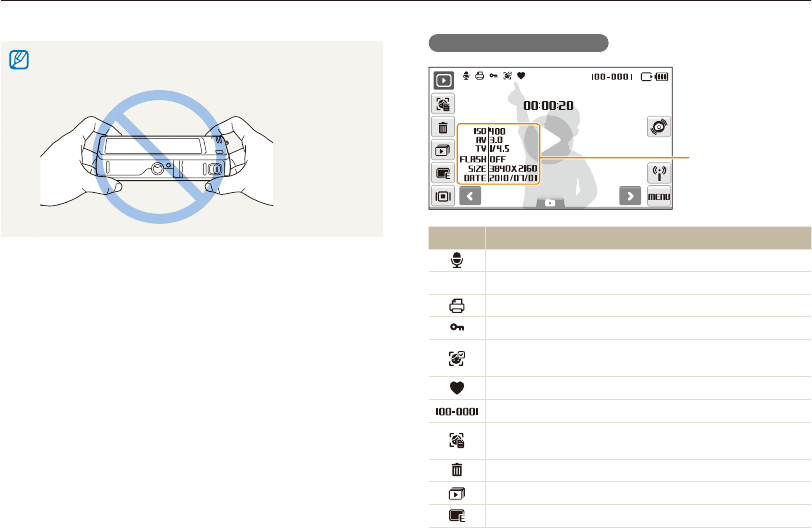
Playback/Editing
67
Playing back
Display in Playback mode
Information
Icon Description
Photo includes a voice memo
v
Video file
Print order has been set (DPOF)
Protected file
Photo includes a registered face; Available only when you
use a memory card
Favorite file
Folder name – File name
Open the face list (p. 68); Available only when you use a
memory card
Delete files (p. 71)
Play a slide show (p. 72)
Edit photos (p. 76)
Motion recognition may not work well if you hold the camera parallel to the
ground, as shown below.
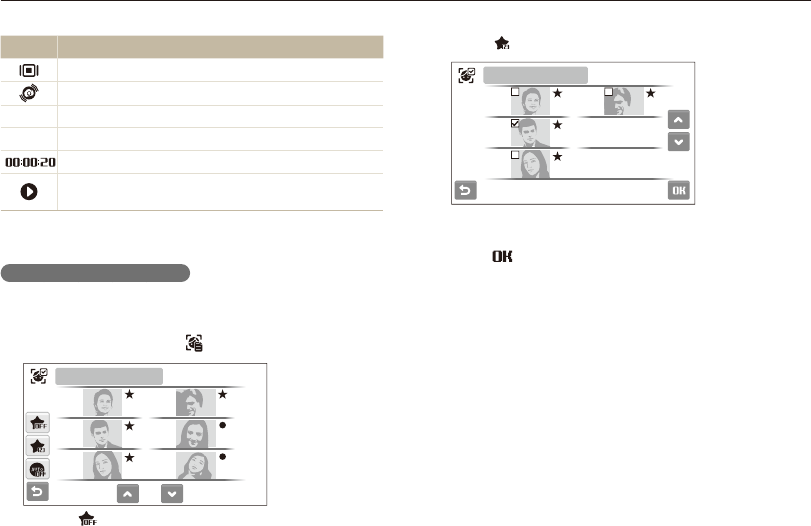
Playback/Editing
68
Playing back
Select
2
a face.
1
2
3
4
Edit Ranking
Select
3
,
or
.
to change the ranking of the face and
select .
Icon Description
Select a display type (p. 24)
Select a menu using motion recognition (p. 66)
N
Use network menus (p. 91)
M
Playback and settings menus
Playback time of videos or voice memos
Play videos or voice memos
(Video p. 73/Voice memo p. 74)
Ranking your favorite faces
You can change the ranking of your favorite faces or delete them.
This feature is available only when you use a memory card.
In Playback mode, select
1
.
1/2
1
2
3
4
5
6
Face List
Select t to cancel your favorite faces.
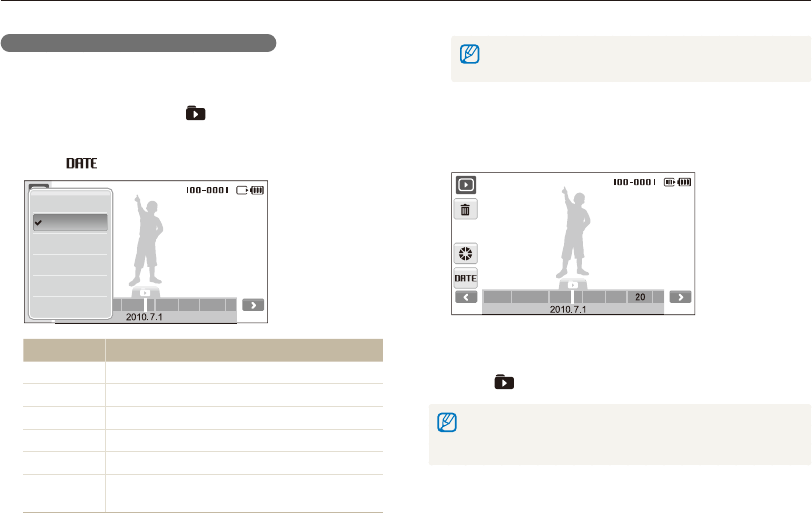
Playback/Editing
69
Playing back
It may take some time for the camera to open Smart Album or to change
the category and reorganize files.
Select a date, file type, weekday, color, or face.
3
You can also touch and hold t
<
or
>
to scroll through dates,
file types, weekdays, colors, or faces.
29 617
Select
4
<
or
>
to scroll through files.
Select
5
to return to the normal view.
Once you select a category and a menu that displays thumbnails (such as
deleting multiple files or protecting selected files), the camera will display all files
sorted by category or only those that match the category option.
Viewing files by category in Smart Album
View and manage files by categories, such as date, file type, or
week.
In Playback mode, select
1
.
You can also access Smart Album by rotating [t Zoom] left.
Select
2
a category.
Option Description
Type View files by the file type.
Date View files by the date they were saved.
Color View files by the dominant color of the image.
Week View files by the weekday they were saved.
Favorite View your favorite files.
Face View files by recognized faces and favorite faces.
(Up to 20 people)
29 61720
Type
Date
Color
Week
Favorite
Face
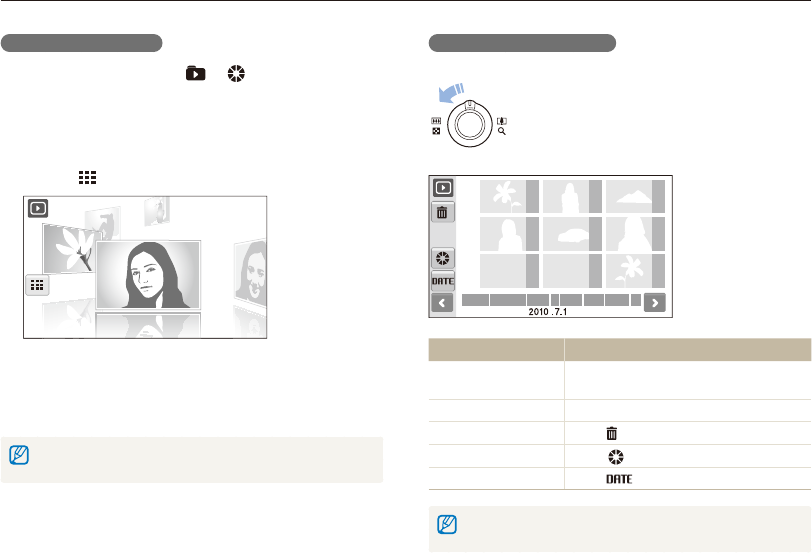
Playback/Editing
70
Playing back
Viewing files as thumbnails
Scan thumbnails of files.
In Playback mode, rotate [Zoom] left to display 9 or
16 thumbnails (rotate [Zoom] right to return to the
previous mode).
29 61720
To Do this
Scroll through files Select
<
or
>
or slide your finger on the
screen left or right to scroll through files.
View a file Select a thumbnail.
Delete files Select . (p. 71)
View in 3D Select .
Select a category Select .
When you drag files in thumbnail mode, indication icons may appear after
thumbnail have loaded.
To view files in 3D view
In Playback mode, select
1
.
Drag files left or right to scroll through files.
2
Drag files left or right to move them more quickly. The farther t
you drag an icon across the screen, the more files you will
scroll through at a time.
Select t to view files in Smart Album.
1/5
Select a file in the middle of the screen to view in the full
3
screen.
Select the file to return to 3D view.t
You cannot play movies or voice memos in 3D view.t
The 3D feature is not available while the camera is connected to a TV.t
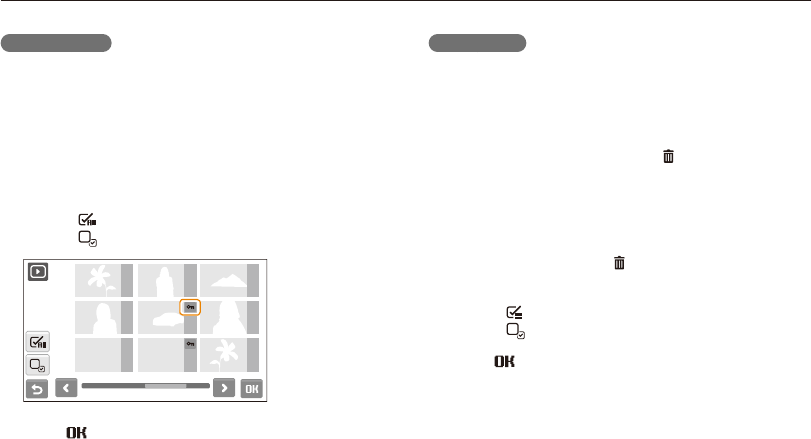
Playback/Editing
71
Playing back
Deleting files
Delete single files or all files at once. You cannot delete protected
files.
To delete a single file,
In Playback mode, select a file
1
.
Select
2
Yes to delete the file.
To delete multiple files,
In Playback mode, select
1
Multiple Delete.
Select files you want to delete.
2
Select t to select all files on the current screen.
Select t to cancel your selection.
Select
3
Yes.
Protecting files
Protect your files from accidental deletion.
To select and protect files,
In Playback mode, select
1
M
.
Select
2
Protect Select.
Select files you want to protect.
3
Select t to select all files.
Select t to cancel your selection.
Select
4
.
To protect all files,
In Playback mode, select
1
M
.
Select
2
Protect All Lock.
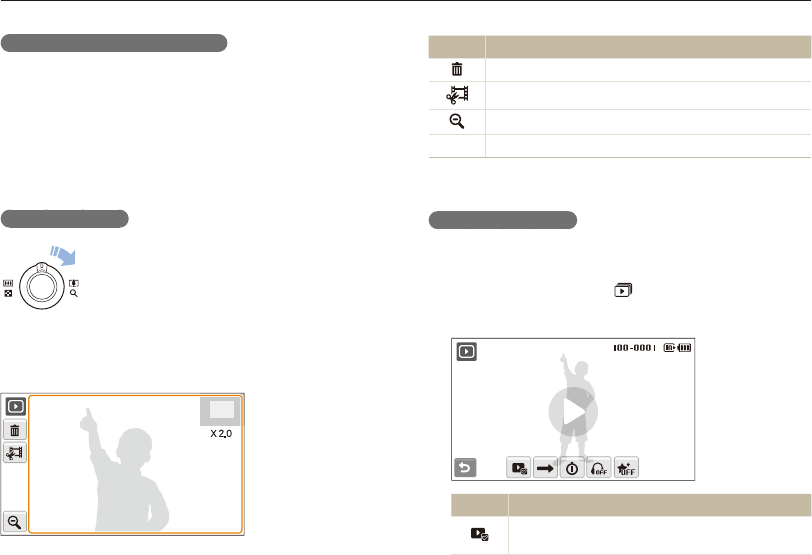
Playback/Editing
72
Playing back
Icon Description
Delete the file.
Crop the enlarged photo (it will be saved as a new file).
Go back to the original view.
X2.0 Zoom ratio
Starting a slide show
You can apply effects and audio to your slide show. This function
does not work for videos or voice memos.
In Playback mode, select
1
.
Set a slide show effect.
2
Option Description
Images: Select photos (up to 2.000) for your slide
show.
Copying files to the memory card
You can copy files from the internal memory to a memory card.
In Playback mode, select
1
M
.
Select
2
.
Copy to Card.
Select
3
Yes to copy files.
Enlarging a photo
In Playback mode, rotate [Zoom] right to enlarge
a photo (rotate [Zoom] left to reduce a photo).
The enlarged area is indicated on the top of the screen.
The maximum zoom ratio may vary depending on the resolution.
Scroll toward the direction you want to move.
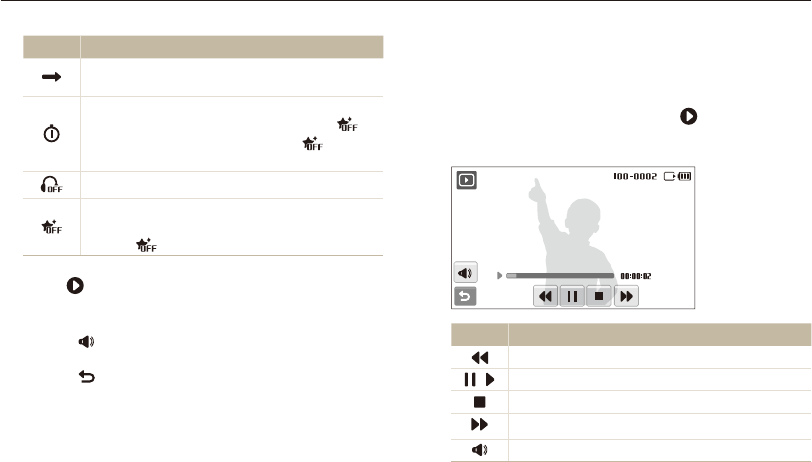
Playback/Editing
73
Playing back
Playing a video
You can play a video, capture an image from a video, or crop a
video.
In Playback mode, select a video
1
.
Use the following icons to control playback.
2
Icon Description
Scan backward.
/ Pause or resume playback.
Stop playback.
Scan forward.
Adjust volume or mute sound.
Option Description
Play Mode: Select whether or not to loop the slide
show.
Interval: Set the interval between photos.
This will be available when you set t Effect to .
When used with an effect option than t , the
interval will be set to 1 sec.
Music: Select background audio.
Effect:
Select a transition effect.t
Select t for no effects.
Select
3
to start the slide show.
Touch on the screen (except for option icons) to pause the t
slide show.
Select t to adjust the volume of background audio or to
mute the sound.
Select t to switch to Playback mode.
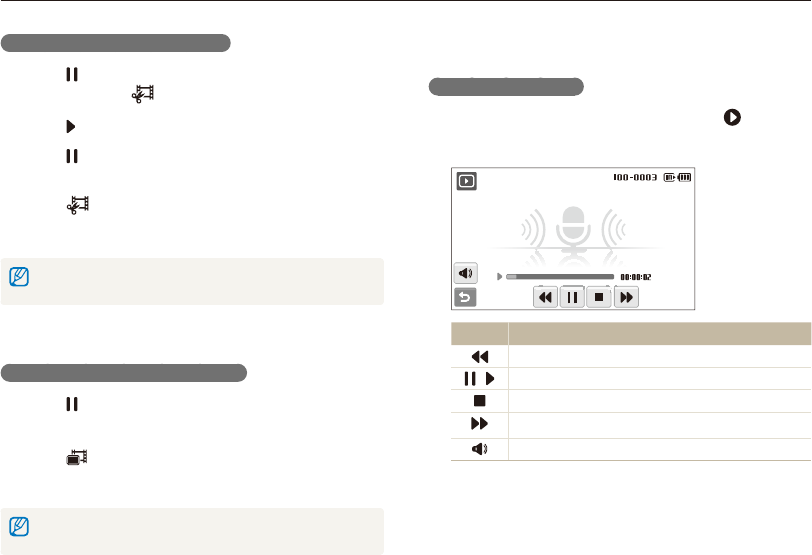
Playback/Editing
74
Playing back
Playing a voice memo
Playing a voice memo
In Playback mode, select a voice memo
1
.
Use the following icons to control playback.
2
Icon Description
Scan backward.
/ Pause or resume playback.
Stop playback.
Scan forward.
Adjust volume or mute sound.
Trimming a video during playback
Select
1
at the point where you want the new video to
begin and select .
Select
2
to resume playback.
Select
3
at the point where you want the new video to
end.
Select
4
.
Select
5
Yes.
The original video should be at least 10 seconds long.t
The edited video will be saved as a new file.t
Capturing an image during playback
Select
1
at the point where you want to save a still
image.
Select
2
.
Select
3
Yes.
A captured image will have the same file size as the original video file and will
be saved as a new file.

Playback/Editing
75
Playing back
Playing a voice memo added to a photo
In Playback mode, select a photo that includes a voice
1
memo .
Use the following icons to control playback.
2
Icon Description
/ Pause or resume playback.
Stop playback.
Adjust volume or mute sound.
Adding a voice memo to a photo
In Playback mode, select a photo
1
M
.
Select
2
Voice Memo On.
Press [
3
Shutter] to record a short voice memo
(10 seconds maximum).
Press [t Shutter] to stop recording a voice memo.
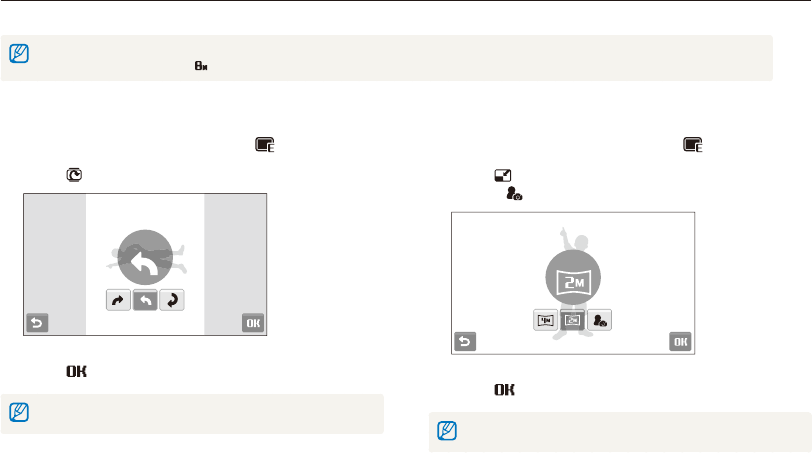
Playback/Editing
76
Editing a photo
Perform photo editing tasks, such as rotating, resizing, eliminating red-eyes, and adjusting brightness, contrast, or saturation.
Edited photos will be saved as new files.t
When you edit photos that are t or larger, they will be automatically resized to a lower resolution (except when rotating or resizing photos).
Resizing photos
In Playback mode, select a photo
1
.
Select
2
an option.
Select t to save the photo as a start image. (p. 108)
1920 X 1080
Select
3
.
Available options differ depending on the size of the selected photo.
Rotating a photo
In Playback mode, select a photo
1
.
Select
2
an option.
Left 90˚
Select
3
.
The rotated photo will be saved as the same file, not a new file.
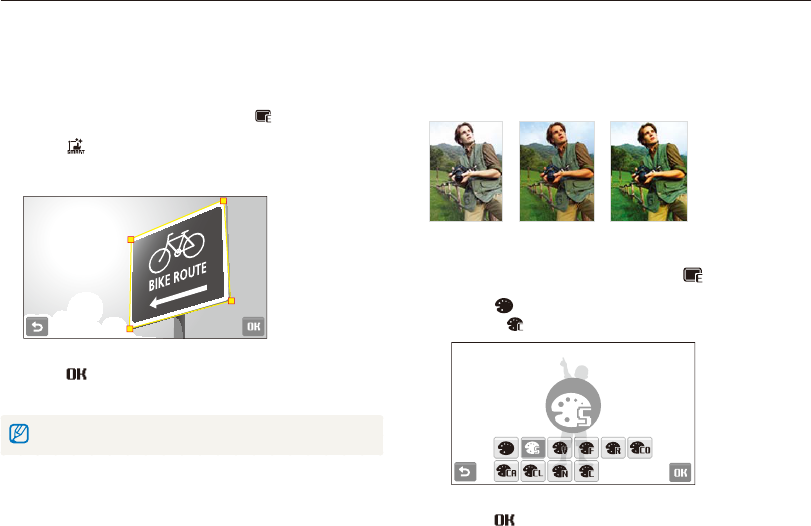
Playback/Editing
77
Editing a photo
Applying photo styles
Apply a different color tone to the photo, such as Soft, Vivid,
or Forest. The edited photo will be saved as a new file but it could
be resized to a lower resolution.
Soft Vivid Forest
In Playback mode, select a photo
1
.
Select
2
an option.
Select t to define your own RGB tone.
Soft
Select
3
.
Using Smart crop
Select part of a photo to enlarge and save the photo
as a new file.
In Playback mode, select a photo
1
.
Select
2
.
Select 4 points on the touch screen to select an area.
3
Select
4
.
The photo is saved as a new file.t
The new file size will be reduced regardless the original size.
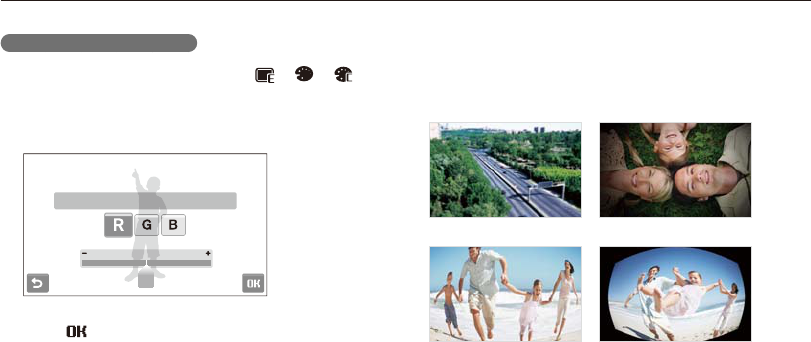
Playback/Editing
78
Editing a photo
Defining your own RGB tone
In Playback mode, select a photo
1
.
Select a color (R: Red, G: Green, B: Blue).
2
Adjust the amount of the color.
3
Custom RGB
Select
4
.
Applying smart filter effects
Apply various filter effects to your photos to create unique images.
The edited photo will be saved as a new file but it could be
resized to a lower resolution.
Miniature Vignetting
Fish-eye 1 Fish-eye 2
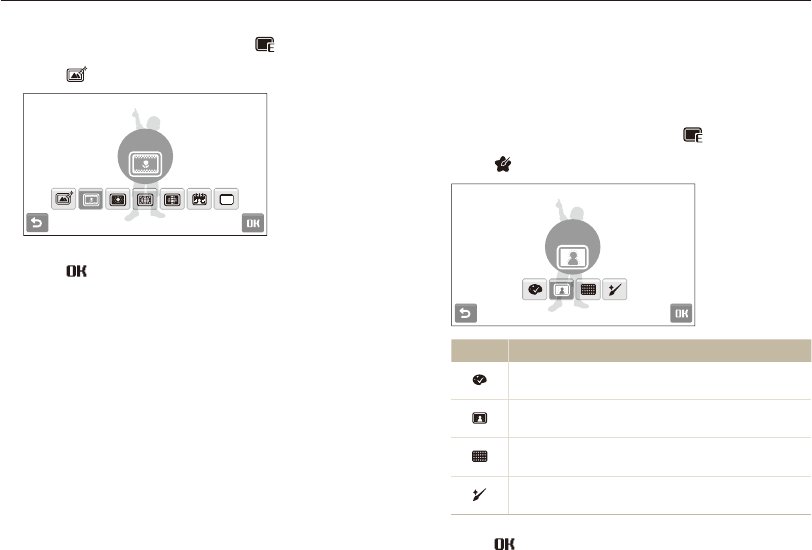
Playback/Editing
79
Editing a photo
Applying a special effect
Apply special effects to the photo, such as color filters or noise
effects. The edited photo will be saved as a new file but it could
be resized to a lower resolution.
In Playback mode, select a photo
1
.
Select
2
an option.
Elegant
Option Description
Color Filter: Change background colors to black and
white to make the main subject stand out.
Elegant: Apply effects to the photo to make it brighter
and softer.
Add Noise: Add noise to the photo to give it an aged
look.
Face Retouch: Retouch the portrait photos and
express faces more brightly and clearer.
Select
3
.
In Playback mode, select a photo
1
.
Select
2
an effect.
Miniature
Select
3
.
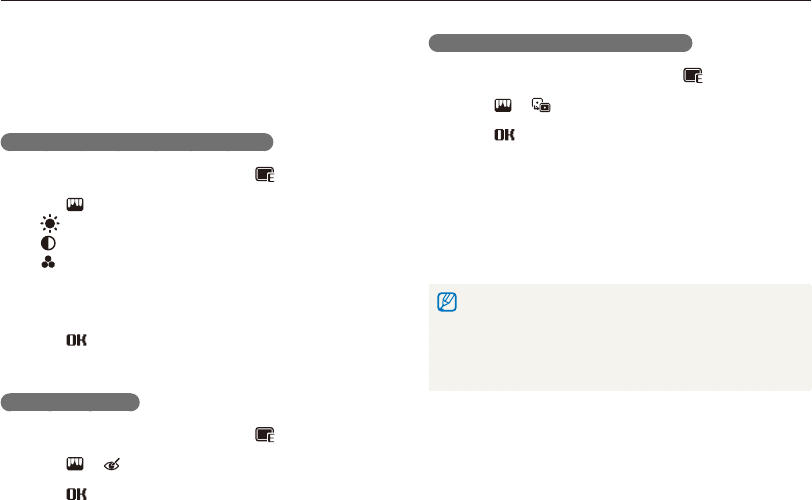
Playback/Editing
80
Editing a photo
Adjusting ACB (Auto Contrast Balance)
In Playback mode, select a photo
1
.
Select
2
.
Select
3
.
Creating a print order (DPOF)
Select photos to be printed and set options, such as number of
copies or paper size.
The memory card can be taken to a print shop that supports DPOF t
(Digital Print Order Format) or you can print photos directly through a
DPOF-compatible printer at home.
Wide photos may print with the left and right edges cut off, so be t
aware of the dimensions of your photos.
You cannot set the DPOF for the photos stored in the internal memory.t
In Playback mode, select
1
M
.
Select
2
DPOF Select.
To print all files, select t All and skip to step
5
.
Adjusting photo
Remove red-eyes or adjust brightness, contrast and saturation.
The edited files are saved as new files but the size may be
reduced.
Adjusting brightness/contrast/saturation
In Playback mode, select a photo
1
.
Select
2
an adjustment option.
t : Brightness
t : Contrast
t : Saturation
Select a value to adjust the selected item.
3
(-: less or +: more)
Select
4
.
Removing red-eyes
In Playback mode, select a photo
1
.
Select
2
.
Select
3
.

Playback/Editing
81
Editing a photo
Select photos to print.
3
Select t to select all files.
Select t to cancel your selection.
Select
4
.
Set
5
DPOF options.
Option Description
Select whether to print the photos as thumbnails.
(Select to print photos as thumbnails.)
Specify the size of the print.
Select
6
,
or
.
to set the number of copies.
Select
7
.
If you specify the print size, you can print photos only with DPOF 1.1-compatible
printers.
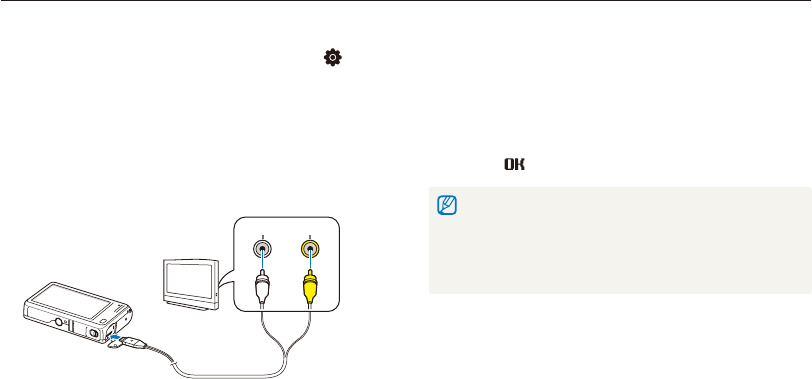
Playback/Editing
82
Viewing files on a TV
Play back photos or videos by connecting your camera to a TV using the A/V cable.
View photos or play videos using the touch screen on
8
your camera.
The touch screen will function as the controller for the TV t
screen. Locate the option you want on the TV screen and
touch where the option is located on the camera screen.
When a pointer appears on the option on the TV screen,
select on the camera screen.
On some TVs, digital noise may occur or part of an image may not t
appear.
Images may not appear centered on the TV screen depending on t
your TV settings.
You can capture photos or videos while the camera is connected t
to a TV.
In Shooting or Playback mode, select
1
M
.
Select
2
.
(twice)Video Out.
Select a video signal output according to your country or
3
region. (p. 111)
Turn off your camera and TV.
4
Connect your camera to your TV using the A/V cable.
5
Video Audio
Turn on your TV and select the video output mode using
6
the TV remote control.
Turn on your camera and press [
7
Playback].

Playback/Editing
83
Transferring files to your computer (for Windows)
Transfer files to your computer using the built-in Intelli-studio program. You can also edit files or upload files to your favorite websites.
Intelli-studio may not perform correctly on some computers, even t
when the computer meets the requirements.
If your computer does not meet the requirements, videos may not play t
correctly or it may take longer to edit videos.
Install DirectX 9.0c or above before you use the program.t
You must use Windows XP/Vista/7 or Mac OS 10.4 or later to t
connect the camera as a removable disk.
Using a self-assembled PC or a PC and OS that are not supported t
may void your warranty.
The programs may not work properly on 64-bit Edition of Windows t
XP, Vista, and 7.
Requirements for Intelli-studio
Item Requirements
CPU Intel Pentium 4, 3.2 GHz or higher/
AMD Athlon
TM
FX 2.6 GHz or higher
RAM Minimum 512 MB RAM
(1 GB and above recommended)
OS Windows XP SP2/Vista/7
Hard disk
capacity 250 MB or more (1 GB and above recommended)
Others
CD-ROM drivert
nVIDIA Geforce 7600GT or higher/ATI X1600 series t
or higher
1024 X 768 pixels, 16-bit color display compatible t
monitor (1280 X 1024 pixels, 32-bit color display
recommended)
USB 2.0 port, Microsoft DirectX 9.0c or latert
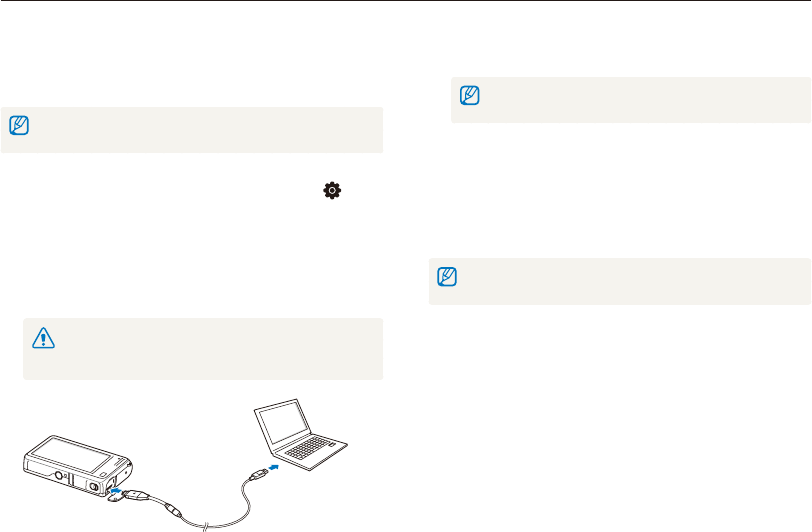
Playback/Editing
84
Transferring files to your computer (for Windows)
Turn on the camera.
5
The computer recognizes the camera automatically.t
If you set the USB option to Select Mode, select Computer from the
pop-up window.
Select a folder on your computer to save new files.
6
If your camera has no new files, the pop-up window for saving t
new files will not appear.
Select
7
Yes.
New files will be transferred to the computer.t
For Windows Vista and Windows 7, select Run iStudio.exe from the
AutoPlay window.
Transferring files using Intelli-studio
Intelli-studio will start automatically when you connect the camera
to your computer with the USB cable.
The battery will be charged while the camera is connected to a computer with
the USB cable.
In Shooting or Playback mode, select
1
M
.
Select
2
.
(twice)PC SoftwareOn.
Turn off the camera.
3
Connect the camera to your computer with the USB
4
cable.
You must plug the end of the cable with the indicator light (S) into
your camera. If the cable is reversed, it may damage your files. The
manufacturer is not responsible for any loss of data.
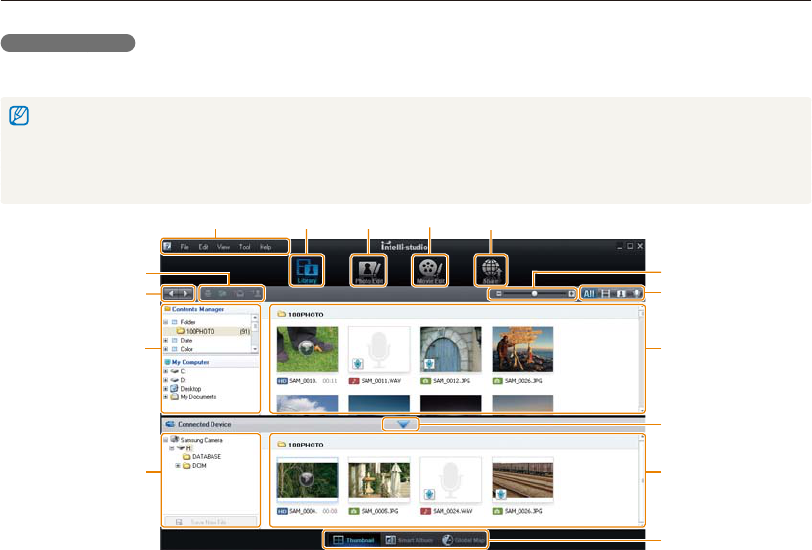
Playback/Editing
85
Transferring files to your computer (for Windows)
Using Intelli-studio
Intelli-studio is a built-in program that allows you to play back and edit files. You can also upload files to websites, such as Flickr or YouTube.
For details, select Help Help in the program.
If you install Intelli-studio on your computer, the program will launch more quickly. To install the program, select t Tool Install Intelli-studio on PC.
You cannot edit files directly on the camera. Transfer files to a folder on your computer before editing.t
You cannot copy files in your computer to the camera.t
Intelli-studio supports the following formats:t
Videos: MP4 (Video: H.264, Audio: AAC), WMV (WMV 7/8/9), AVI (MJPEG) -
Photos: JPG, GIF, BMP, PNG, TIFF -
1
7
8
0
2345
6
@
#
9
$
%
!
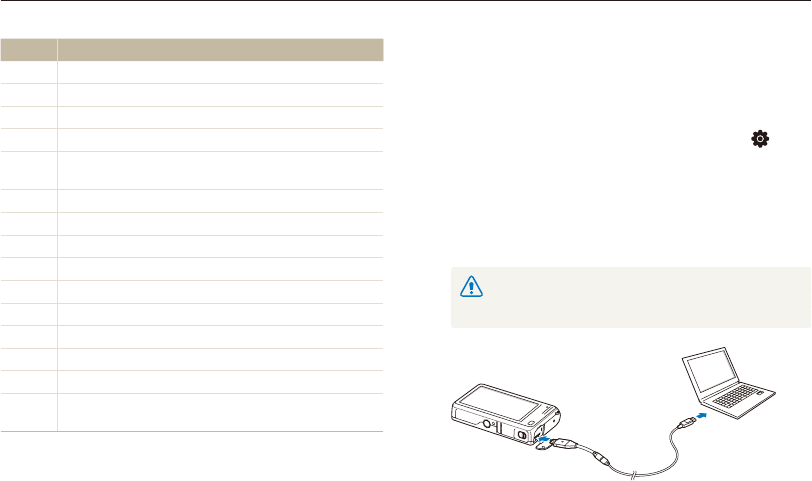
Playback/Editing
86
Transferring files to your computer (for Windows)
Transferring files by connecting the camera
as a removable disk
You can connect the camera to your computer as a removable
disk.
In Shooting or Playback mode, select
1
M
.
Select
2
.
(twice) PC Software Off.
Turn off the camera.
3
Connect the camera to your computer with the USB
4
cable.
You must plug the end of the cable with the indicator light (S) into
your camera. If the cable is reversed, it may damage your files. The
manufacturer is not responsible for any loss of data.
Icon Description
1
Open menus
2
Display files in the selected folder
3
Change to the Photo edit mode
4
Change to the Video edit mode
5
Change to the Sharing mode (You can send files by email
or upload files to websites, such as Flickr or YouTube.)
6
Enlarge or reduce the thumbnails in the list
7
Select a file type
8
View files of the selected folder on your computer
9
Show or hide files of the connected camera
0
View files of the selected folder on the camera
!
View files as thumbnails, in Smart Album, or on a map
@
Browse folders in the connected device
#
Browse folders in your computer
$
Move to the previous or next folder
%
Print files, view files on a map, store files in My Folder, or
register faces

Playback/Editing
87
Transferring files to your computer (for Windows)
Disconnecting the camera (for Windows XP)
The way to disconnect the USB cable for Windows Vista/7 is
similar.
If the status lamp on your camera is blinking, wait until
1
it stops.
Click
2
on the tool bar at the bottom right of your PC
screen.
Click the pop-up message.
3
Remove the USB cable.
4
The camera may not be removed safely when Intelli-studio is running.
End the program before disconnecting the camera.
Turn on the camera.
5
The computer recognizes the camera automatically.t
If you set the USB option to Select Mode, select Computer from the
pop-up window.
On your computer, select
6
My computer Removable
Disk DCIM 100PHOTO.
Select the files you want and drag or save them to your
7
computer.
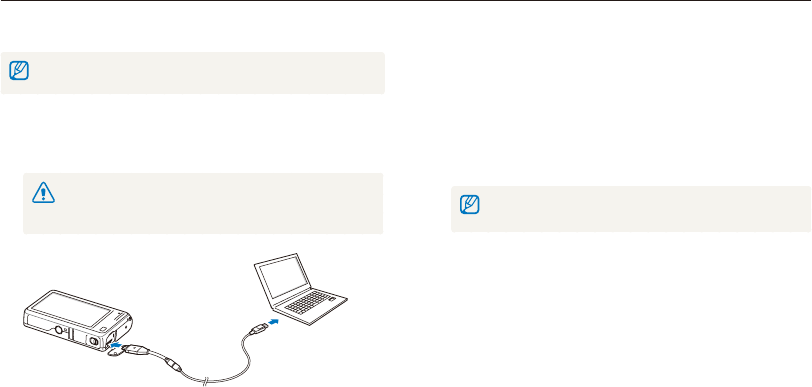
Playback/Editing
88
Transferring files to your computer (for Mac)
When you connect the camera to a Macintosh computer, the computer will recognize the device automatically. You can transfer files directly
from the camera to the computer without installing any programs.
Mac OS 10.4 or later is supported.
Turn on the camera.
2
The computer recognizes the camera automatically and a t
removable disk icon will be displayed.
If you set the USB option to Select Mode, select Computer from the
pop-up window.
Double-click the removable disk icon.
3
Transfer photos or videos to the computer.
4
Connect your camera to a Macintosh computer with the
1
USB cable.
You must plug the end of the cable with the indicator light (S) into
your camera. If the cable is reversed, it may damage your files. The
manufacturer is not responsible for any loss of data.
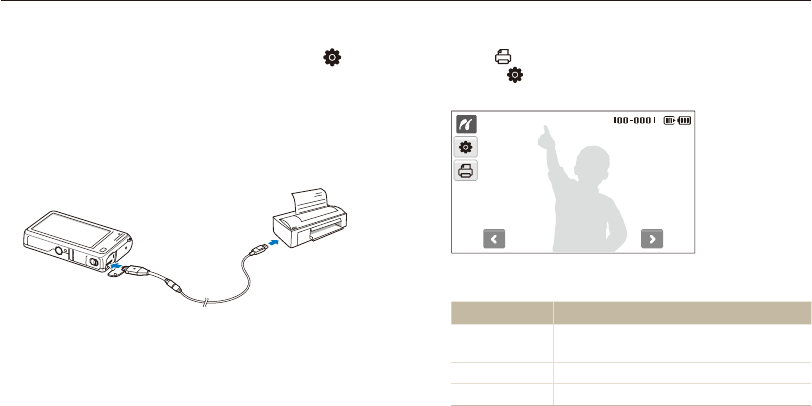
Playback/Editing
89
Printing photos with a photo printer (PictBridge)
Print photos with a PictBridge-compatible printer by connecting your camera directly to the printer.
Select
6
to print.
Select t to set printing options.
See “Configuring print settings” on page 90.
Select an option.
7
Option Description
Current Photo Print the currently selected photo.
Skip to step
9
.
Selected Photos Print the photos you want.
All Photos Print all photos. Skip to step
9
.
In Shooting or Playback mode, select
1
M
.
Select
2
.
(twice) USB Printer.
Turn off the camera.
3
With the printer on, connect your camera to the printer
4
with the USB cable.
Turn on your camera.
5
The printer recognizes the camera automatically.t
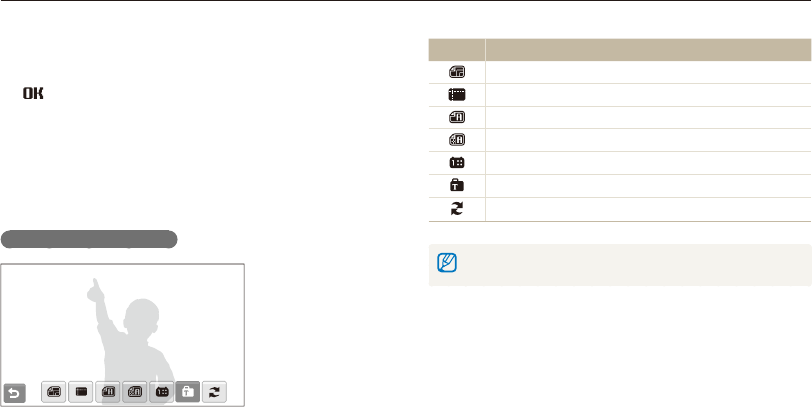
Playback/Editing
90
Printing photos with a photo printer (PictBridge)
Option Description
Size: Specify the size of the print.
Layout: Create thumbnail prints.
Type: Select the type of paper.
Quality: Set the printing quality.
Date: Set to print the date.
File Name: Set to print the name of the file.
Reset: Reset the print options.
Some options are not supported by some printers.
Select
8
<
or
>
to scroll to a photo to print.
Select
9
,
or
.
to set the number of copies and select
.
If you chose t Selected Photos, repeat steps
8
and
9
for all
photos you want to print.
Select
10
Yes to confirm.
Printing starts. Select t Cancel to cancel printing.
Configuring print settings

Connecting to a WLAN and configuring
network settings ……………………………… 92
Connecting to a WLAN automatically ………… 92
Setting network options ……………………… 93
Setting IP manually …………………………… 93
Network connection tips ……………………… 94
Storing your information ……………………… 95
Storing email addresses ……………………… 95
Setting the file size to share …………………… 96
Setting a password …………………………… 96
Changing the password ……………………… 96
Checking information ………………………… 97
Entering text …………………………………… 97
Using photo or video sharing websites … 98
Accessing a website …………………………… 98
Uploading photos or videos …………………… 99
Sending photos via email ……………… 100
Viewing photos or videos on the allshare
devices ……………………………………… 101
Viewing photos or videos on a TV screen … 101
Viewing photos or videos on another device
(renderer) …………………………………… 102
Sending or receiving photos or videos
with a camera ……………………………… 104
Sending photos or videos to another camera 104
Receiving photos or videos from another
camera ……………………………………… 104
Wireless network
Learn to use several functions that use wireless local area networks (WLANs) feature.
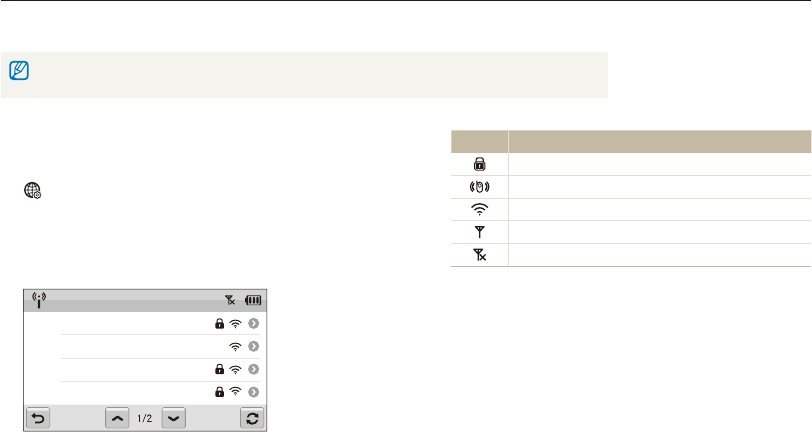
Wireless network
92
Icon Description
Secured AP
Ad hoc AP
Signal strength
Signal is found.
No signal is found.
If the selected AP is not secured, the camera will connect to t
the WLAN.
If the selected AP device requires a password, enter the t
password to connect to the WLAN.
Connecting to a WLAN automatically
In Shooting or Playback mode, select
1
N
Network Setting.
Select
2
Access Point Setting.
The camera will search for and display available AP devices.t
Select an AP device.
3
AP Setting
AIA-2
Samsung 1
Samsung 2
Samsung 3
Connecting to a WLAN and configuring network settings
Learn to connect via an access point (AP) when you are in a range of a WLAN. You can also configure network settings and learn
how to enter text.
This camera uses non-harmonized frequencies and is intended for use in all European countries.
The WLAN can be operated indoors in the EU without restriction, but cannot be operated outdoors in France.
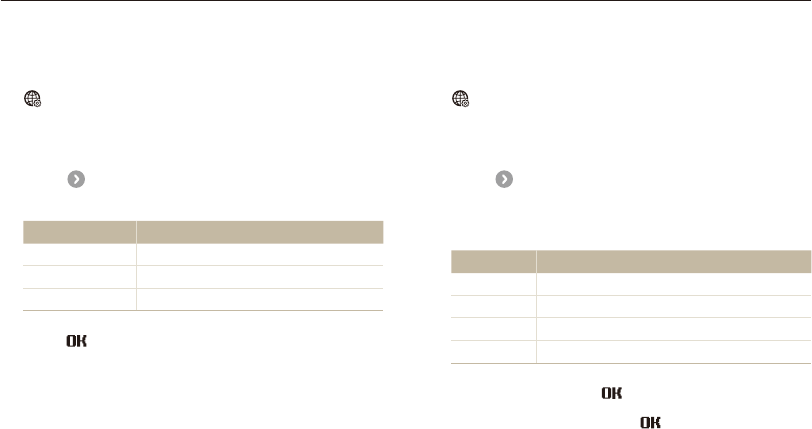
Wireless network
93
Connecting to a WLAN and configuring network settings
Setting IP manually
In Shooting or Playback mode, select
1
N
Network Setting.
Select
2
Access Point Setting.
The camera will search for and display available AP devices.t
Select
3
next to the AP you want to connect.
Select
4
IP Setting Manual.
Select the boxes next to the options you will set.
5
Option Description
IP Enter the static IP address.
Subnet Mask Enter the subnet mask.
Gateway Enter the gateway.
DNS Server Enter the DNS address.
Enter values and select
6
.
When you are finished, select
7
.
Setting network options
In Shooting or Playback mode, select
1
N
Network Setting.
Select
2
Access Point Setting.
The camera will search for and display available AP devices.t
Select
3
next to the AP you want to set.
Select network options.
4
Option Description
Authentication Select a network authentication.
Data Encryption Select an encryption type.
Network Key Select Touch and enter the Network Key.
Select
5
.

Wireless network
94
Connecting to a WLAN and configuring network settings
You can use only free WLANs with your camera. If you use t
free WLANs that require the user agreement and additional
information when you connect to a web browser, some features
may be limited when connecting to websites or sending email.
Available network connections may differ by country. t
The WLAN feature of your camera must comply with radio t
transmission laws in your region. To ensure compliance, use
the WLAN feature only in the country where you purchased the
camera.
For network profiles and a password, contact your network t
administrator or network service provider.
The process for adjusting network settings may differ, t
depending on network conditions.
Do not access a network that you are unauthorized to use.t
When connecting to networks, ensure your battery is fully t
charged.
When a DHCP server is not available you must make an autoip.t
txt file and copy it to the inserted memory card to connect to
the network using Auto IP.
Network connection tips
The quality of the network connection will be determined by t
the AP.
The further the distance between your camera and the AP, the t
longer will take to connect to the network.
If a nearby device is using the same radio frequency signal as t
your camera, it may interrupt your connection.
If your AP name is not in English, the device may not be located t
or the name may appear incorrect.
For network settings or a password, contact your network t
administrator or network service provider.
If a WLAN requires authentication from the service provider, you t
may not be able to connect it. To connect the WLAN, contact
your network service provider.
Depending on the encryption type, the number of digits in the t
password may differ.
A WLAN connection may not be possible in all surroundings.t
A WLAN-enabled printer may be shown on the AP lists. t
However, you cannot connect to the network via a printer.
You cannot connect your camera to a network and a TV t
simultaneously. Also you cannot view photos or videos on a TV
while connected to a network.
Connecting to a network may incur additional charges. Costs t
will vary based on the conditions of your contract.
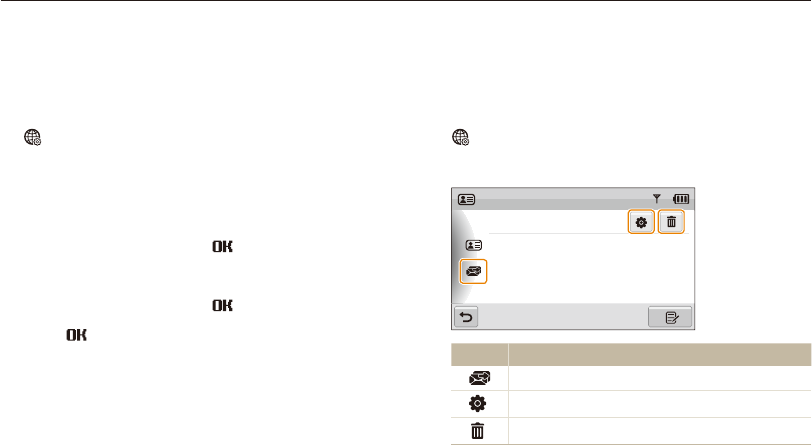
Wireless network
95
Connecting to a WLAN and configuring network settings
Storing email addresses
Store up to 10 email addresses in your camera. You can use
them when you send your photos via email.
In Shooting or Playback mode, select
1
N
Network Setting.
Select
2
Email Address.
Email Address Book
Samsung
Icon Description
Display the email addresses you used recently.
*Edit the email address.
*Delete the email address.
* The icons will appear after you store an email address.
Storing your information
Store your name and email address to send emails or to find your
camera on another device.
In Shooting or Playback mode, select
1
N
Network Setting.
Select
2
User Setting.
Select the name input field and enter your name.
3
For information about entering text, refer to page t 97.
When you are finished, select
4
.
Select the email input field and enter your email address.
5
When you are finished, select
6
.
Select
7
to save your information.
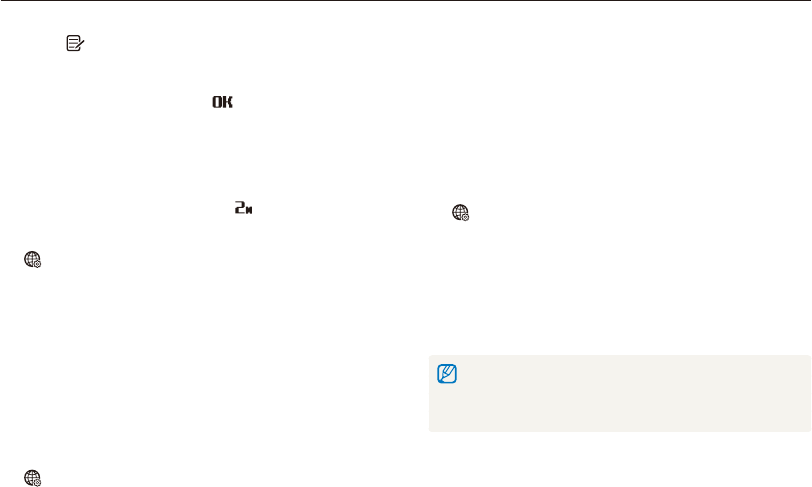
Wireless network
96
Connecting to a WLAN and configuring network settings
Enter a password (4 digits).
3
Enter the password (4 digits) again.
4
Changing the password
Change the password if necessary.
In Shooting or Playback mode, select
1
N
Network Setting.
Select
2
.
Change Password.
Enter the current password (4 digits).
3
Enter a new password (4 digits).
4
Enter the new password (4 digits) again.
5
To reset a password, select Reset from the password input window.
If you reset the password, your stored email addresses, recently sent email
addresses, and all personal information will be deleted to protect user
information.
Select
3
.
Enter a name and email address.
4
When you are finished, select
5
.
Setting the file size to share
Set the file size you will share with other allshare-enabled devices.
You can select either the original size or .
In Shooting or Playback mode, select
1
N
Network Setting.
Select
2
DLNA -Image Size.
Select a size.
3
Setting a password
Restrict sending emails and configuring network settings by
setting a password.
In Shooting or Playback mode, select
1
N
Network Setting.
Select
2
.
Setting Password On Confirm.
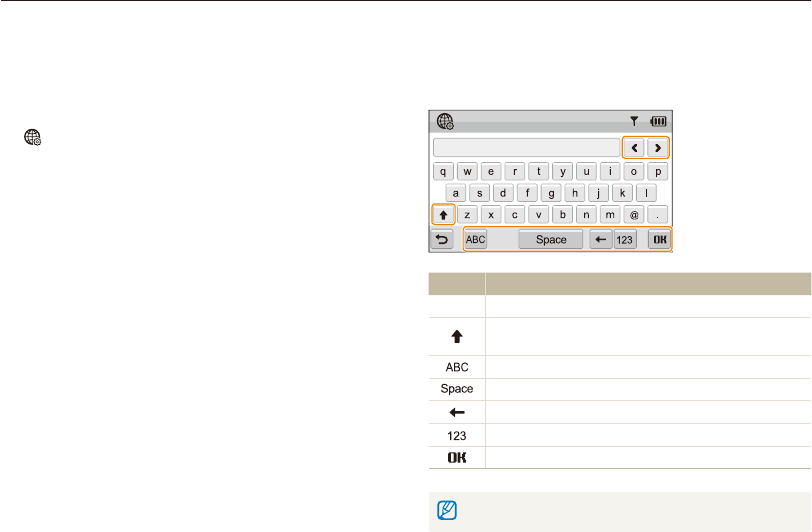
Wireless network
97
Connecting to a WLAN and configuring network settings
Entering text
To enter text when storing your information or email addresses,
select the appropriate letters, symbols, and numbers.
User Setting: Name
Icon Description
<
/
>
Move the cursor.
In ABC mode, change the cases. In 123 mode, view more
symbols.
Switch to ABC mode.
Enter a space.
Delete the last letter.
Switch to 123 mode.
Store the displayed text.
You can enter text only in English, regardless of the display language.
Checking information
Check the Mac address and serial number of your camera to
register it with the Samsung website.
In Shooting or Playback mode, select
1
N
Network Setting.
Select
2
.
Device Information.
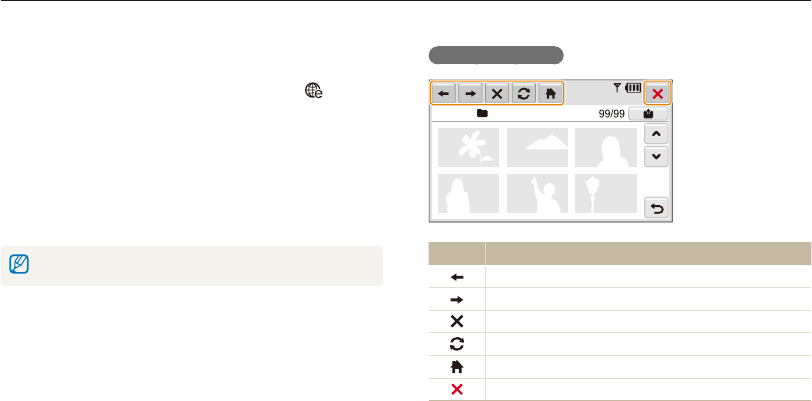
Wireless network
98
Using photo or video sharing websites
Upload your photos or videos to file sharing websites (available websites will be displayed on your camera).
Icons on a website
Icon Description
Previous page
Next page
Stop
Refresh
Home
Close
Accessing a website
In Shooting or Playback mode, select
1
N
Web .
The camera automatically connects to the WLAN via the last t
connected AP device.
If the camera has not connected to the WLAN, it automatically t
searches for available AP devices. (p. 92)
Select a website.
2
Enter your login ID and password, and select
3
Login .
You must create your account on web in advance.
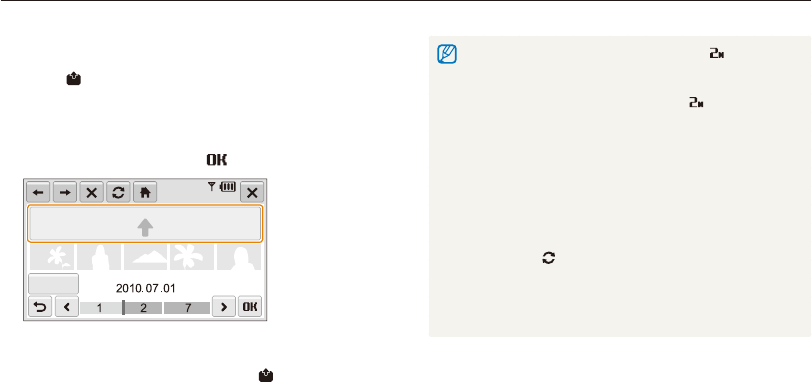
Wireless network
99
Using photo or video sharing websites
The maximum photo resolution you can upload is t , and the longest
video you can upload is 30 seconds at 320 X 240 resolution or the
video recorded using For Sharing.
If the selected photo resolution is higher than t , it will be
automatically resized to a lower resolution.
When the total size of all photos selected is smaller than 10 MB, you t
can upload them to a website (up to 20 photos).
Methods of uploading photos or videos may differ depending on the t
selected website.
If you cannot access a website because of firewall or user t
authentication settings, contact your network administrator or network
service provider.
When you are not able to upload photos or videos due to server t
errors, select .
Titles for photos or videos you are uploading could be the date they t
are captured.
The speed of your internet connection may affect how quickly photos t
upload or web pages open.
Uploading photos or videos
Select
1
.
Select
2
<
or
>
to scroll through files.
Drag photos or videos to the selection area or select
3
photos or videos, and select .
Date
Select t Date to categorize the files. (p. 69)
Enter an album tittle, and then select
4
.
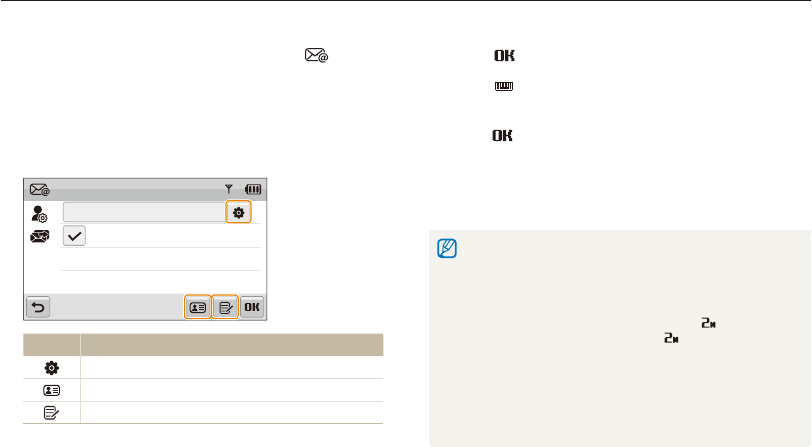
Wireless network
100
Sending photos via email
Select
3
.
Select
4
and enter your email text.
Select photos, or drag photos to the selection area and
5
select .
The photos will be sent to the selected email addresses.t
The t Transfer completed. message will still appear, even
when photos cannot be sent or be sent as spam due to an
error with the recipient's email account.
When the total size of all photos selected is smaller than 10 MB, you t
can send them via email (up to 20 photos).
You can enter up to 10 recipients for each email.t
You may not be able to send an email due to network connection or t
email account settings.
The maximum photo resolution you can send is t and if the
selected photo resolution is higher than , it will be automatically
resized to a lower resolution.
If you cannot send an email because of firewall or user authentication t
settings, contact your network administrator or network service
provider.
When there are no photos in the camera memory, you cannot use t
this feature.
In Shooting or Playback mode, select
1
N
Email.
The camera automatically connects to the WLAN via the last t
connected AP device.
If the camera has not connected to the WLAN, it automatically t
searches for available AP devices. (p. 92)
Enter email addresses for the sender and receiver.
2
Sender/ Receiver
Samsung
Samsung 1
Icon Description
Enter or modify the email address of the sender.
Retrieve the stored email addresses.
Enter an email address manually.

Wireless network
101
Viewing photos or videos on the allshare devices
allshare is an international technology standard for sharing media files between networked devices in your home. With this technology, you
can view your photos or videos on a widescreen TV or another device. You cannot send or receive voice memos.
On the TV, search for the camera and browse the shared
4
photos or videos.
Your camera’s name is what you entered in the user setting. t
(p. 95)
For information about searching for the camera and browsing t
the photos or videos on the TV, refer to the TV user manual.
Videos may not play smoothly depending on type of TV or t
network condition. If this happens, re-record the video in
640 X 480 or 320 X 240 quality and play it again. If videos do
not play smoothly on your TV over the wireless connection,
connect the camera to the TV with an A/V cable.
Viewing photos or videos on a TV screen
View your photos or videos on a TV that supports the allshare
function.
In Shooting or Playback mode, select
1
N
Broadcast files.
The camera automatically connects to the WLAN via the last t
connected AP device.
If the camera has not connected to the WLAN, it automatically t
searches for the available AP devices. (p. 92)
Select
2
Selected Files.
To share all files, select t All Files and skip to step
4
.
Select photos or videos to share.
3
You can share up to 1,000 photos or videos.

Wireless network
102
Viewing photos or videos on the allshare devices
Viewing photos or videos on another device
(renderer)
In Shooting or Playback mode, select
1
N
Send files.
The camera automatically connects to the WLAN via the last t
connected AP device.
If the camera has not connected to the WLAN, it automatically t
searches for the available AP devices. (p. 92)
If the camera has connected to the WLAN, it automatically t
searches for and displays the available allshare-enabled
devices. However, searching for the devices may take some
time.
Select a device (renderer) that will play the photos or
2
videos.
Drag a photo or video to the selection area or select a
3
photo or video.
The photos or videos will appear on the device’s screen.t
To view other photos or videos, drag a photo or video to the t
selection area one by one on your camera.
On a TV screen, you can view only photos or videos captured with t
your camera.
The range of the wireless connection between your camera and a TV t
may vary depending on the specifications of the AP.
If the camera is connected to 2 TVs, playback may be slowed.t
The photos will be shared according to the size you set. (p. t 96)
The videos will be shared in their original sizes.
You can use this feature only with a allshare-enabled Digital Media t
Players (DMPs).
Shared photos or videos will not be stored on the TV, but they can be t
stored according to the TV specifications.
Transferring photos or videos to the TV may take some time t
depending on the network connection and the file size.
If you power off the camera abnormally while viewing photos or videost
on a TV (ex. removing battery), the TV considers the camera to still
be connected.
The order of photos or videos on the camera and TV could be t
different.
Depending on the number of photos or videos you want to share, it t
may take some time to load your photos or videos and complete the
initial set-up process.
While viewing photos or videos on the TV, continuously using the TV t
remote or performing additional operations on the TV may prevent this
feature from working properly.
If you reorder or sort files on the camera while viewing them on a TV, t
you must repeat the initial set-up process to update the list of files
on the TV.
When there are no photos or videos in the camera memory, you t
cannot use this feature.

Wireless network
103
Viewing photos or videos on the allshare devices
When searching for allshare-enabled devices in the area, the camera t
may not list all available devices.
If you power off the device abnormally while viewing photos or videos t
on a device, the camera considers the device to still be connected.
The photos will be shared according to the size you set. (p. t 96)
The videos will be shared in their original sizes.
You can use this feature only with an allshare-enabled renderer.t
The shared photos or videos will not be stored on the device, but t
some TVs may store photos or videos, depending on its memory
capabilities and settings.
Transferring photos or videos to the device may take some time t
depending on the network connection and the file size.
You can transfer files one by one.t
When there are no photos or videos in the camera memory, you t
cannot use this feature.
On other devices (renderer), you can view only photos or videos t
captured with your camera.
Network conditions will affect the duration of a search. If the search t
takes an unusually long time try reconnecting the camera to the
network.

Wireless network
104
Sending or receiving photos or videos with a camera
Learn to send or receive photos or videos to or from camera of the same model. You cannot send or receive voice memos.
Receiving photos or videos from another
camera
In Shooting or Playback mode, select
1
N
Camera to Camera .
Select
2
Receive on your camera.
On the sending camera, select t Send and after some time,
select Receive.
Select the name of the sending camera.
3
Enter the sending camera’s password.
4
The password will appear on the screen of the sending t
camera.
When the sending camera transmits photos or videos, they t
will appear on the receiving camera.
Sending photos or videos to another camera
In Shooting or Playback mode, select
1
N
Camera to Camera .
Select
2
Send.
The camera generates a password and displays it on the t
screen while waiting for a connection with the receiving
camera.
On the receiving camera, select the name of the sending
3
camera.
The sending camera’s name is what you entered in the user t
setting. (p. 95)
Enter the password (4 digits) on the receiving camera.
4
The selection area automatically appears on the sending t
camera.
Drag photos or videos to the selection area or select
5
them.
The photos or videos will be sent to the receiving camera.t

Wireless network
105
Sending or receiving photos or videos with a camera
This feature uses an ad hoc wireless network.t
If you most recently used your camera to receive files, you must end t
the connection and reassign your camera as sender to send files.
The range of the wireless connection between two cameras may vary, t
depending on the conditions of the wireless ad-hoc network.
If a camera turns off abnormally while sending or receiving photos or t
videos, the other camera considers the camera to still be connected.
Cameras will be disconnected after some time.
It may take some time to send or receive photos or videos depending t
on the file size and the ad hoc network connection.
You can transfer files one by one.t
If you fail to receive or send a photo or video, it will not be saved on t
the receiving camera.
If no photos have been stored on the camera, you cannot use this t
feature.
You can send and receive photos or videos taken with your camera or t
other camera only.
If you select the original size in the allshare-image size setting, you can t
send or receive the photos without transformation. However, if you
select and the selected photo resolution is higher than , it will
be automatically resized to a lower resolution. (p. 96)
You can send or receive videos smaller than 35 MB only.t

Settings menu
………………………………………… 107
Accessing the settings menu
…………………………… 107
Sound settings
………………………………………… 108
Display settings
………………………………………… 108
Camera settings
………………………………………… 109
Settings
Refer to options to configure your camera’s settings.
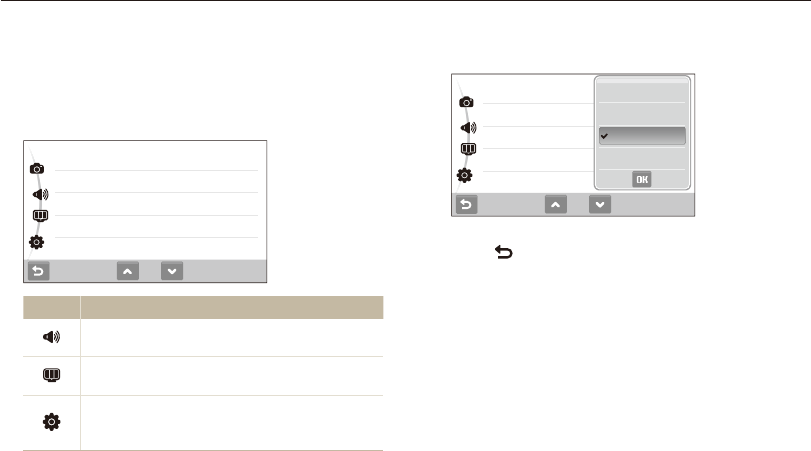
Settings
107
Settings menu
Learn about various options to configure your camera’s settings.
Select an option and save your settings.
3
1/2
Volume
Beep Sound
Shutter Sound
Start Sound
AF Sound
Off
Low
Medium
High
Select
4
to return to the previous screen.
Accessing the settings menu
In Shooting or Playback mode, select
1
M
.
Select a menu.
2
1/2
Volume
Beep Sound
Shutter Sound
Start Sound
AF Sound
: Medium
: On
: 1
: Off
: On
Icon Description
Sound settings: Set various camera sounds and
volume. (p. 108)
Display settings: Customize the display settings,
such as brightness. (p. 108)
Camera settings: Change the settings for the camera
system, such as memory format, default file name, and
USB mode. (p. 109)
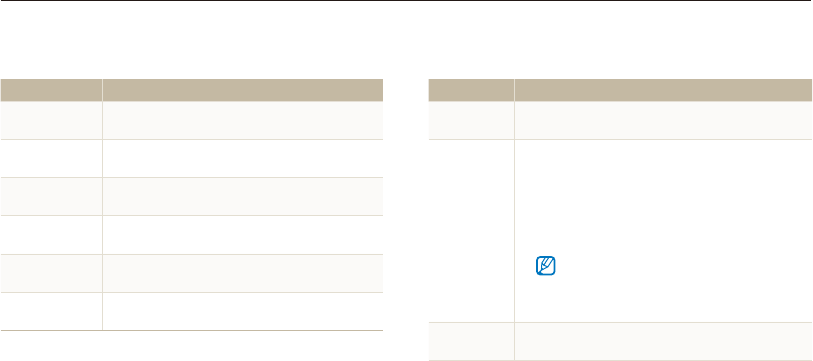
Settings
108
Settings menu
Sound settings
* Default
Item Description
Volume Adjust the volume of any sound.
(Off, Low, Medium*, High)
Beep Sound Select a sound to be emitted when touching on
the screen or switching modes. (Off, On*)
Shutter Sound Select a sound to be emitted when pressing the
shutter button. (Off, 1*, 2, 3)
Start Sound Select a sound to be emitted when turning on your
camera. (Off*, 1, 2, 3)
AF Sound Set a sound to be emitted when half-pressing the
shutter button. (Off, On*)
Self-Portrait Set to emit a sound when the camera detects
your face. (Off, On*)
Display settings
* Default
Item Description
Function
Description
Display a brief description of an option or menu.
(Off, On*)
Start Image
Set a start image to display when the camera turns
on.
Offt *: Display no start image.
Logot : Display a default image stored in the internal
memory.
User Image t : Display the image you want. (p. 76)
Only one user image will be saved in the internal t
memory.
If you select a new photo as a user image or reset t
your camera, the current image will be deleted.
Grid Line Select a grid to help you compose a scene.
(2 X 2*, 3 X 3, +, X)

Settings
109
Settings menu
Camera settings
* Default
Item Description
Format
Format the internal memory and the memory card
(all files-including the protected files-will be deleted).
(No, Yes)
If you use a memory card used with cameras from different
manufacturers or a memory card reader, or one formatted
on a computer, your camera may read the card incorrectly.
Format the card in your camera before using it.
Reset
Reset menus and shooting options (date and time,
language, and video output settings will not be reset).
(No, Yes)
Language Select a language for the display text.
Time Zone Select a region and set the daylight-saving time
(DST).
Date/Time
Set Set the date and time.
Date Type Select a date format (YYYY/MM/DD,
MM/DD/YYYY, DD/MM/YYYY, Off*)
Item Description
Display
Brightness
Adjust the brightness of the screen.
(Auto*, Dark, Normal, Bright)
Normal is fixed in Playback mode even if Auto is selected.
Quick View
Set the duration for reviewing a captured image
before returning to Shooting mode.
(Off, 0.5 sec*, 1 sec, 3 sec)
Power Save
If you perform no operations for 30 seconds, the
camera automatically switches to Power save mode
(press any button to deactivate Power save mode).
(Off*, On)
* Default

Settings
110
Settings menu
Item Description
Imprint
Set whether to display the date and time on your
photos when printing. (Off*, Date, Date & Time)
The date and time will be displayed on the bottom-t
right corner of the photo in yellow.
The date and time may not be printed on some t
printer models.
If you selectt Text in
s
mode, the date and
time will not be displayed.
Auto Power
Off
Set the camera to automatically turn off when you are
not using it. (Off, 1 min, 3 min*, 5 min, 10 min)
Your settings will not change after replacing the t
battery.
The camera will not automatically turn off when:t
it is connected to a computer or printer -
you are playing a slide show or videos -
you are recording a voice memo -
AF Lamp Set an assistant light to help you focus in dark places.
(Off, On*)
Item Description
File No.
Specify how to name files.
Resett : Set the file number to start from 0001 when
inserting a new memory card, formatting a memory
card, or deleting all files.
Seriest *: Set the file number to follow the previous
file number when inserting a new memory card,
formatting a memory card, or deleting all files.
The default name of the first folder is 100PHOTO and t
the default name of the first file is SAM_0001.
The file number increases one by one from t
SAM_0001 to SAM_9999.
The folder number increases one by one from t
100PHOTO to 999PHOTO.
The maximum number of files that can be stored in t
one folder is 9,999.
The camera defines file names according to the t
Digital rule for Camera File system (DCF) standard.
If you change the names of files intentionally, the
camera may not play back the files.
* Default * Default

Settings
111
Settings menu
Item Description
Video Out
Set the video signal output according to your region.
NTSCt *: USA, Canada, Japan, Korea, Taiwan,
Mexico
PALt (supports only BDGHI): Australia, Austria,
Belgium, China, Denmark, England, Finland,
Germany, Italy, Kuwait, Malaysia, Netherlands,
New Zealand, Norway, Singapore, Spain, Sweden,
Switzerland, Thailand
USB
Set the function to use via a USB connection with a
computer or printer.
Computert *: Connect your camera to a computer
for transferring files.
Printert : Connect your camera to a printer for
printing files.
Select Modet : Select a USB mode when you
connect your camera to another device.
PC Software Set Intelli-studio to start automatically when you
connect your camera to your computer. (Off, On*)
Touch
Calibration
Calibrate the screen so that your camera will properly
recognize the input.
* Default

Error messages
……………………………………… 113
Camera maintenance
………………………………… 114
Cleaning your camera
………………………………… 114
About memory cards
…………………………………… 115
About the battery
……………………………………… 116
Before contacting a service center
………………… 119
Camera specifications
……………………………… 122
FCC notice
…………………………………………… 126
Index
…………………………………………………… 130
Appendixes
Refer to error messages, specifications, and maintenance tips.

Appendixes
113
Error messages
When the following error messages appear, try these remedies.
Error message Suggested remedies
Invalid password.
The password for transferring files to
another camera is wrong. Enter the
correct password again.
Low Battery Insert a charged battery or recharge the
battery.
Memory Full Delete unnecessary files or insert a new
memory card.
No Image File Take photos or insert a memory card
that has some photos.
Photo reception failed.
The camera fails to receive a photo
from the sending camera. Ask the other
person to send the file again.
Transfer failed.
The camera fails to send a photo. t
Try sending again.
The camera fails emailing or sending t
to an allshare-enabled device. Ensure
the network is available and try
connecting agian.
Error message Suggested remedies
Card Error
Turn off your camera and then turn t
it on again.
Remove your memory card and insert t
it again.
Format your memory card.t
Card not supported.
The inserted memory card is not
available with your camera. Insert a
microSD
TM
or microSDHC
TM
memory
card.
Connection failed.
The camera cannot connect to the t
network using the selected access
point. Select another and try again.
The camera fails to connect to the t
other camera. Try connecting again.
DCF Full Error
File names do not match the DCF
standard. Transfer the files on the
memory card to your computer and
format the card. (p. 109)
Device disconnected. Connect to a device again.
File Error Delete the damaged file or contact a
service center.
Initialization failed.
Turn on allshare enabled devices on t
the network.
The camera fails to locate an allshare-t
enabled device.
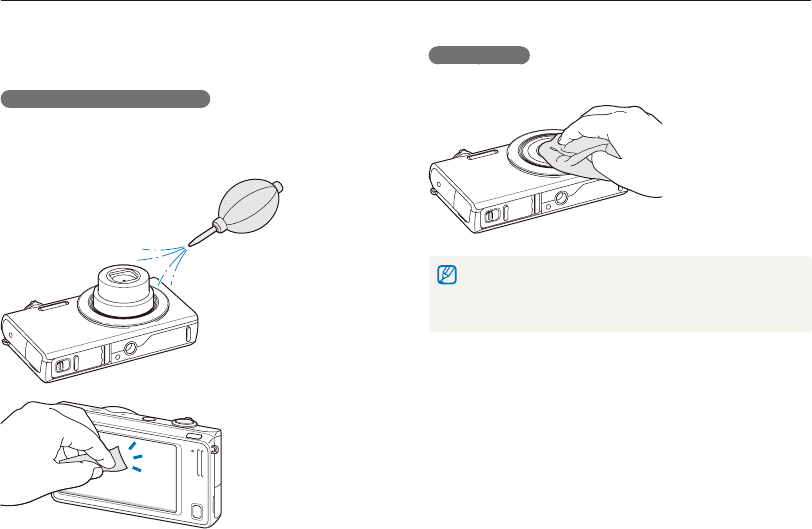
Appendixes
114
Camera maintenance
Camera body
Wipe gently with a soft, dry cloth.
Never use benzene, thinners, or alcohol to clean the device. t
These solutions can damage the camera or cause it to malfunction.
Do not press on the lens cover or use a blower brush on the lens t
cover.
Cleaning your camera
Camera lens and touch screen
Use a blower brush to remove dust and wipe the lens gently with
a soft cloth. If any dust remains, apply lens cleaning liquid to a
piece of cleaning paper and wipe gently.
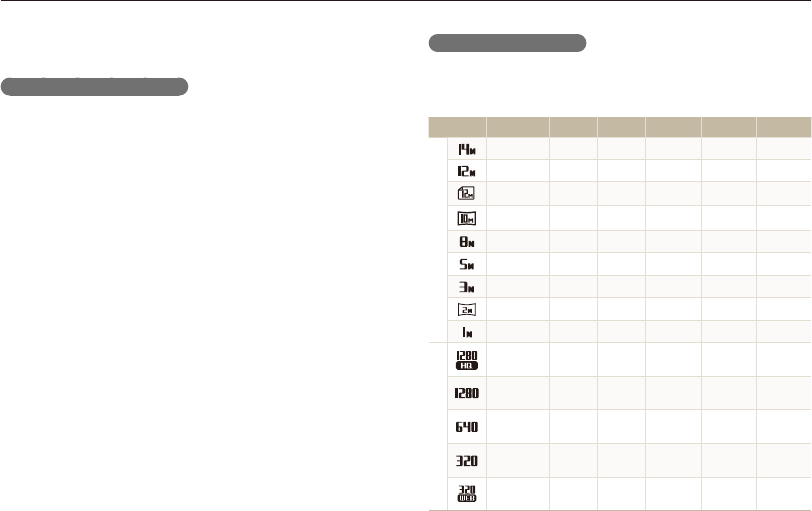
Appendixes
115
Camera maintenance
Memory card capacity
The memory capacity may differ depending on shooting scenes
or shooting conditions. These capacities are based on a 1 GB
microSDTM card:
Size Super Fine Fine Normal 60 FPS 30 FPS 15 FPS
P
h
o
t
o
s
122 240 353 - - -
142 278 409 - - -
137 267 391 - - -
163 320 471 - - -
211 409 594 - - -
335 637 908 - - -
510 936 1,314 - - -
762 1,373 1,931 - - -
1,626 2,574 3,089 - - -
*
V
i
d
e
o
s
----
Approx.
13' 30"
Approx.
23' 36"
----
Approx.
15' 20"
Approx.
29' 42"
----
Approx.
35' 54"
Approx.
67' 30"
---
Approx.
78' 07"
Approx.
138' 19"
Approx.
237' 41"
----
Approx.
30” -
* The recordable time may vary if you use the zoom.
Several videos were recorded in succession to determine the total
recording time.
About memory cards
Memory cards you can use
You can use microSDTM (Secure Digital) or microSDHCTM (Secure
Digital High Capacity) memory cards.

Appendixes
116
Camera maintenance
Battery life
Average time /
Number of photos
Test conditions
(when the battery is fully charged)
Photos
Approx. 100 min/
Approx. 200
photos
This is measured under the following
conditions: in
a
mode, 14M resolution
and Normal quality.
1. Set the flash option to Fill in, take a
single shot, and zoom in or out.
2. Set the flash option to Off, take a
single shot, and zoom in or out.
3. Perform steps 1 and 2 for 30
seconds and repeat for 5 minutes.
Then turn off the camera for 1 minute.
4. Repeat steps 1 to 3.
Videos Approx. 80 min Record videos at 1280 X 720 HQ
resolution and 30 fps.
The figures above are measured by Samsung’s standards and may differ t
depending on actual usage.
Several videos were recorded in succession to determine the total recording t
time.
When using network functions, the battery will be depleted more quickly.t
About the battery
Use only Samsung-approved batteries.
Battery specifications
Model BP-70A
Type Lithium-ion battery
Cell capacity 740 mAh (Minimum: 700 mAh)
Voltage 3.7 V
Charging time
(when the camera is switched off) Approx. 150 min
* Charging the battery by attaching the USB cable to a PC and your camera
may take longer.

Appendixes
117
Camera maintenance
Notes about charging the battery
If the indicator light is off, make sure that the battery is inserted t
correctly.
Do not use your camera when charging. Turn off the camera before t
charging the battery.
Turn on your camera after charging the battery for more than 10 t
minutes.
Using the flash or recording videos depletes the battery quickly. t
Charge the battery until the indicator light turns green.
If the indicator light blinks in orange or does not illuminate, reconnect t
the cable, or remove the battery and insert it again.
If you charge the battery when the cable is overheated or the t
temperature is too high, the indicator light may turn orange. Charging
will start when the battery cools down.
Do not pull a power supply cord to disconnect the plug from the t
power outlet. This may cause a fire or electric shock.
Do not bend or place heavy objects on the AC cable. Doing so may t
damage the cable.
Notes about charging with a computer connected
Use only the provided USB cable.t
The battery may not be charged when:t
you use a USB hub -
other USB devices are connected to your computer -
you connect the cable to the port on the front side of your -
computer
the USB port of your computer does not support the power output -
standard (5 V, 500 mA)

Appendixes
118
Camera maintenance
Do not disassemble or puncture the battery with any t
sharp object.
Avoid exposing the battery to high pressure or crushing t
forces.
Avoid exposing the battery to major impacts, such as t
dropping it from high places.
Do not expose the battery to temperatures of 60° C t
(140° F) or above.
Do not allow the battery to come in contact with moisture t
or liquids.
Battery shall not be exposed to excessive heat such as t
sunshine, fire or the like.
Disposal guidelines
Dispose of the battery with care.t
Do not dispose of the battery in a fire.t
Disposal regulations may differ by country or region. t
Dispose of the battery in accordance with all local and
federal regulations.
Guidelines for charging the battery
Charge the battery only by the method described in this user
manual. The battery can ignite or explode if not charged
properly.
Personal injury or death can occur if the battery is
handled carelessly or improperly. For your safety,
follow these instructions for proper battery handling:
The battery can ignite or explode if not handled properly. If t
you notice any deformities, cracks, or other abnormalities
in the battery, immediately discontinue use of the battery
and contact your manufacturer.
Use only authentic, manufacturer-recommend battery t
chargers and adapters and charge the battery only by the
method described in this user manual.
Do not place the battery near heating devices or expose t
to excessively warm environments, such as the inside of
an enclosed car in the summertime.
Do not place the battery in a microwave oven.t
Avoid storing or using the battery in hot, humid places, t
such as spas or shower enclosures.
Do not rest the device on flammable surfaces, such as t
bedding, carpets, or electric blankets for a prolonged
period.
When the device is switched on, do not leave it in any t
confined space for a prolonged period.
Do not allow battery terminals to come in contact with t
metallic objects, such as necklaces, coins, keys, or
watches.
Use only authentic, manufacturer-recommended, Lithium-t
ion replacement batteries.

Appendixes
119
Before contacting a service center
If you are having trouble with your camera, try these troubleshooting procedures before contacting a service center. If you have attempted
the troubleshooting solution and are still having problems with your device, contact your local dealer or service center.
When you leave your camera at a service center, be sure to also leave the other components that may have contributed to the malfunction, such as the memory card and battery.
Situation Suggested remedies
Cannot take photos
There is no space on the memory card. t
Delete unnecessary files or insert a new
card.
Format the memory card. (p. t 109)
The memory card is defective. Get a t
new memory card.
Make sure that the camera is switched t
on.
Charge the battery.t
Make sure that the battery is inserted t
correctly.
The camera freezes Remove the battery and insert it again.
The camera heats up
While using the camera, it may heat up.
This is normal and should not affect your
camera’s lifespan or performance.
The flash does not work
The flash option may be set to t Off.
(p. 45)
You cannot use the flash in t
D
,
v
, or
some
s
modes.
The flash fires
unexpectedly
The flash may fire due to static electricity.
This is not a malfunction of the camera.
Situation Suggested remedies
Cannot turn on the
camera
Make sure that the battery is inserted.t
Make sure that the battery is inserted t
correctly.
Charge the battery.t
The power turns off
suddenly
Charge the battery.t
Your camera may be in Power save t
mode. (p. 109)
The camera may turn off to prevent the t
memory card from being damaged due
to an impact. Turn on your camera again.
The camera is losing
battery power quickly
The battery may lose power more quickly t
in low temperatures (below 0° C). Keep
the battery warm by putting it into your
pocket.
Using the flash or recording videos t
depletes the battery quickly. Recharge
if needed.
Batteries are consumable parts that must t
be replaced over time. Get a new battery
if the battery life is diminishing quickly.

Appendixes
120
Before contacting a service center
Situation Suggested remedies
The photo is blurry
Make sure that the focus option you set t
is suitable for close-up shots. (p. 47)
Make sure that the lens is clean. If not, t
clean the lens. (p. 114)
Make sure that the subject is within t
range of the flash. (p. 122)
The colors in the photo
do not match the actual
scene
An incorrect white balance can create
unrealistic color. Select the proper white
balance option to suit the light source.
(p. 57)
The photo is too bright
Turn off the flash. (p. t 45)
Your photo is overexposed. Adjust the t
exposure value. (p. 54)
The photo is too dark
Your photo is underexposed.
Turn on the flash. (p. t 45)
Adjust the ISO speed. (p. t 46)
Adjust the exposure value. (p. t 54)
The TV does not
display your photos
Make sure that the camera is correctly t
connected to the external monitor with
the A/V cable.
Make sure that your memory card t
contains photos.
Situation Suggested remedies
The date and time are
incorrect
Set the date and time in the display settings
menu. (p. 108)
The touch screen or
buttons do not work Remove the battery and insert it again.
The camera screen
works poorly
If you use your camera at very low
temperatures, it may cause the camera
screen to malfunction or discolor.
For better performance of your camera
screen, use your camera in moderate
temperatures.
The memory card has
an error
Turn off your camera and then turn it t
on again.
Remove your memory card and insert t
it again.
Format your meory card.t
See “Protect batteries, chargers, and memory
cards from damage” for more detail. (p. 2)
Cannot play back files
If you change the name of a file, your
camera may not play the file (the name of
the file should meet the DCF standard). If
you encounter this situation, play back files
on your computer.

Appendixes
121
Before contacting a service center
Situation Suggested remedies
Your computer does
not recognize your
camera
Make sure that the USB cable is t
connected correctly.
Make sure that your camera is switched t
on.
Make sure that you are using a t
supported operating system.
Your computer
disconnects the camera
while transferring files
The file transmission may be interrupted by
static electricity. Disconnect the USB cable
and connect it again.
Your computer cannot
play videos
Depending on the video player programs,
video files may not play. To play video files
captured with your camera, install and use
the Intelli-studio program on your computer.
(p. 85)
Intelli-studio is not
functioning properly
End Intelli-studio and restart the program.t
You cannot use Intelli-studio on t
Macintosh computers.
Make sure that the t PC Software is set
to On in the settings menu. (p. 111)
Depending on your computer's t
specification and environments, the
program may not launch automatically.
In this case, click Start My
Computer Intelli-studio
iStudio.exe on your computer.

Appendixes
122
Camera specifications
Shutter speed
Auto
t : 1/8 - 1/1,500 sec.
Program
t : 1 - 1/1,500 sec.
Night
t : 8 - 1/1,500 sec.
Fireworks
t : 2 sec.
Exposure
Control Program AE
Metering Multi, Spot, Center-weighted
Compensation ±2EV (1/3EV steps)
ISO equivalent Auto, 80, 100, 200, 400, 800, 1600, 3200
Flash
Mode Off, Auto, Red-eye, Fill in, Slow Sync, Red-eye Fix
Range Wide: 0.4 m - 3.6 m (ISO Auto)
t
Tele: 0.5 m - 1.9 m (ISO Auto)t
Recharging time Approx. 4 sec.
Shake reduction
Digital Image Stabilization (DIS)
Image sensor
Type 1/2.3" (Approx. 7.76 mm) CCD
Effective pixels Approx. 14.2 mega-pixels
Total pixels Approx. 14.5 mega-pixels
Lens
Focal length Samsung lens f = 6.3 - 18.9 mm
(35 mm film equivalent: 35 - 105 mm)
F-stop range F3.0 (W) - F5.6 (T)
Digital zoom Still image mode: 1.0X - 3.0X
Display
Type WQVGA LCD
Feature 3.0" Wide Full Touch Screen Panel
Focusing
Type
TTL auto focus (Multi AF, Center AF, Face Recognition
AF, Face Detection AF, Smart Touch AF, One Touch
Shooting)
Range
Wide (W) Tele (T)
Normal 80 cm - infinity 80 cm - infinity
Macro 10 cm - 80 cm 50 cm - 80 cm
Auto Macro 10 cm - infinity 50 cm - infinity

Appendixes
123
Camera specifications
Videos
Modes:
t Smart Scene Detection (Landscape,
Blue Sky, Natural Green, Sunset Sky), Movie
Format: MP4 (H.264) (Max recording time: 20 min)
t
Size: t 1280 X 720 HQ (30 FPS, 15 FPS),
1280 X 720 (30 FPS, 15 FPS), 640 X 480 (30 FPS,
15 FPS), 320 X 240 (60 FPS, 30 FPS, 15 FPS),
320 X 240 For Sharing (30 FPS)
Frame Rate
t : 60 FPS, 30 FPS, 15 FPS
Effect:
t Photo Style Selector , White Balance,
Smart Filter
Voice
t : Off, On, Zoom Mute
Video editing (embedded): Pause during recording,
t
Still image capture, Time trimming
Playback
Type
Single image, Thumbnails, Multi slide show with music
and effects, Movie clip, Smart Album*
* Smart Album category: Type, Date, Color, Week,
Face, Favorite
Edit Resize, Rotate, Smart Crop, Photo Style Selector ,
Image Adjust, Smart Filter, Special Effect, Trim
Effect
Shooting mode
Photo Style Selector
t : Normal, Soft, Vivid, Forest,
Retro, Cool, Calm, Classic, Negative, Custom RGB
Smart Filter
t : Normal, Miniature, Vignetting,
Fish-eye 1, Fish-eye 2, Sketch, Defog
Image Adjust
t : Sharpness, Contrast, Saturation
White Balance
Auto WB, Daylight, Cloudy, Fluorescent_H, Fluorescent_L, Tungsten,
Custom Set
Date Imprinting
Date & Time, Date, Off
Shooting
Photos
Modes:
t Smart Auto (Portrait, Night Portrait,
Backlight Portrait, Backlight, Landscape, White,
Action, Tripod, Night, Macro, Macro Text, Blue Sky,
Sunset Sky, Natural Green, Macro Portrait,
Macro Color, Fireworks), Auto, Program, Scene
(Night, Portrait, Children, Landscape, Text,
Close Up, Sunset, Dawn, Backlight, Fireworks,
Beach & Snow, Frame Guide, Beauty Shot)
Drive
t : Single, Continuous, Motion Capture, AEB
Timer
t : 10 Sec, 2 Sec, Double, Motion Timer
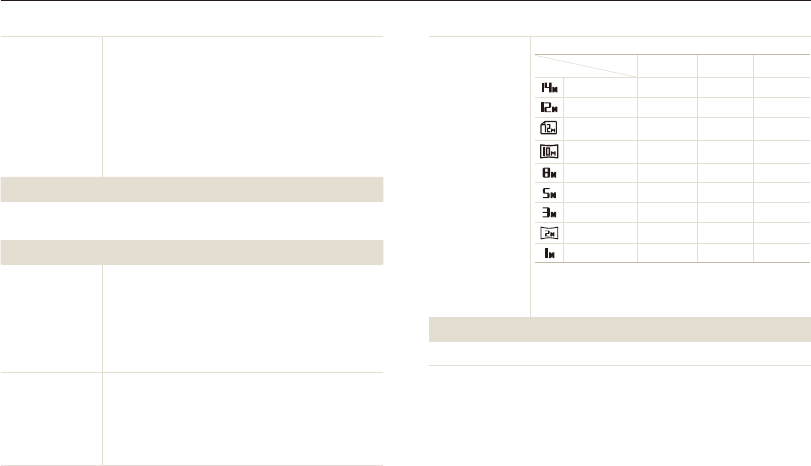
Appendixes
124
Camera specifications
Image size
For 1GB microSD
TM
Super Fine Fine Normal
4320 X 3240 122 240 353
4000 X 3000 142 278 409
4320 X 2880 137 267 391
4320 X 2432 163 320 471
3264 X 2448 211 409 594
2560 X 1920 335 637 908
2048 X 1536 510 936 1,314
1920 X 1080 762 1,373 1,931
1024 X 768 1,626 2,574 3,089
These figures are measured under Samsung’s
standard conditions and may vary depending on
shooting conditions and camera settings.
Wireless network
Wi-Fi (IEEE 802.11 b/g), allshare
Effect
Photo Style Selector
t : Normal, Soft, Vivid, Forest,
Retro, Cool, Calm, Classic, Negative, Custom RGB
Image Adjust
t : ACB, Brightness, Contrast,
Saturation, Red-eye Fix
Smart Filter
t : Normal, Miniature, Vignetting,
Fish-eye 1, Fish-eye 2, Sketch, Defog
Special Effect
t : Color Filter, Elegant, Add Noise,
Face Retouch
Voice recording
Voice Recording (Max. 10 hours)
t
Voice Memo in a photo (Max. 10 sec.)t
Storage
Media
Internal memory: Approx. 22 MB
t
External memory (Optional): microSDt
TM
card
(up to 2 GB guaranteed), microSDHC
TM
card
(up to 8 GB guaranteed)
Internal memory capacity may not match these
specifications.
File format
DCF, EXIF 2.21, DPOF 1.1, PictBridge 1.0
t
Still Image : JPEG (DCF)t
Movie Clip : MP4 t
(Video: MPEG4.AVC/H.264, Audio: AAC)
Audio file : WAV
t

Appendixes
125
Camera specifications
Interface
Digital output
connector USB 2.0
Audio output Mono (Internal speaker), Mono (Microphone)
Video output A/V: NTSC, PAL (selectable)
DC power input
connector 20 pin, 4.2V
Power source
Rechargeable
battery Lithium-ion battery (BP-70A, 740 mAh)
The power source may differ depending on your region.
Dimensions (W x H x D)
92 x 55.4 x 18.5 mm
Weight
108 g (without battery and memory card)
Operating temperature
0 - 40˚ C
Operating humidity
5 - 85 %
Software
Intelli-studio
Specifications are subject to change without prior notice.

Appendixes
126
FCC notice
Declaration of Conformity t
Trade Name : Samsung Electronics America, Inc.
Model No. : Samsung SH100
Responsible Party : Samsung Electronics America, Inc.
Address : 105 Challenger Road, Ridgefield Park,
NJ 07660
Telephone No. : 1-800-SAMSUNG (726-7864)
This device complies with Part 15 of the FCC Rules.
Operation is subject to the following two conditions:
(1) This device may not cause harmful interference, and (2)
this device must accept any interference received, including
interference that may cause undesired operation.
FCC ID:A3LSH100
This device complies with part 15 of the FCC Rules. Operation is subject to the
following two conditions: (1) This device may not cause harmful interference, and
(2) this device must accept any interference received, including interference that
may cause undesired operation.
Caution:
Any changes or modifications in construction of this device which are not
expressly approved by the party responsible for compliance could void the user's
authority to operate the equipment.
NOTE:
This equipment has been tested and found to comply with the limits for a Class
B digital device, pursuant to part 15 of the FCC Rules. These limits are designed
to provide reasonable protection against harmful interference in a residential
installation. This equipment generates, uses and can radiate radio frequency
energy and, if not installed and used in accordance with the instructions,
may cause harmful interference to radio communications. However, there is
no guarantee that interference will not occur in a particular installation. If this
equipment does cause harmful interference to radio or television reception,
which can be determined by turning the equipment off and on, the user is
encouraged to try to correct the interference by one or more of the following
measures:
- Reorientate, or relocate, the receiving antenna.
- Increase the distance between the equipment and receiver.
- Connect the equipment into an outlet on a circuit different from that to which
the receiver is connected.
- Consult the dealer or an experienced radio / TV technician for help.
RF exposure statements:
This device is for handheld operation only. The antenna(s) used for this
transmitter must be installed to provide a separation distance of at least 20 cm
from all persons and must not be co-located or operating in conjunction with any
other antenna or transmitter.

Appendixes
127
Correct Disposal of This Product
(Waste Electrical & Electronic Equipment)
(Applicable in the European Union and other European
countries with separate collection systems)
This marking on the product, accessories or literature indicates that
the product and its electronic accessories (e.g. charger, headset, USB
cable) should not be disposed of with other household waste at the
end of their working life. To prevent possible harm to the environment
or human health from uncontrolled waste disposal, please separate
these items from other types of waste and recycle them responsibly to
promote the sustainable reuse of material resources. Household users
should contact either the retailer where they purchased this product,
or their local government office, for details of where and how they can
take these items for environmentally safe recycling. Business users
should contact their supplier and check the terms and conditions of the
purchase contract. This product and its electronic accessories should
not be mixed with other commercial wastes for disposal.
Correct disposal of batteries in this product
(Applicable in the European Union and other European
countries with separate battery return systems)
This marking on the battery, manual or packaging indicates that
the batteries in this product should not be disposed of with other
household waste at the end of their working life. Where marked, the
chemical symbols Hg, Cd or Pb indicate that the battery contains
mercury, cadmium or lead above the reference levels in EC Directive
2006/66. If batteries are not properly disposed of, these substances
can cause harm to human health or the environment.
To protect natural resources and to promote material reuse, please
separate batteries from other types of waste and recycle them through
your local, free battery return system.
This Class [B] digital apparatus complies with Canadian
ICES-003.
PlanetFirst represents Samsung Electronics'
commitment to the sustainable development and
social responsibility through eco-driven business and
management activities.

Appendixes
128
CAUTION
RISK OF EXPLOSION IF BATTERY IS REPLACED BY
AN INCORRECT TYPE.
DISPOSE OF USED BATTERIES ACCORDING
TO THE INSTRUCTIONS.
Operation is subject to the following two conditions:
(1) This device may not cause harmful interference, and
(2) This device must accept any interference received,
including interference that may cause undesired operation.
Caution:
Any changes or modifications to the equipment not expressly
approved by the party responsible for compliance could void
user’s authority to operate the equipment.
IC: 649E-SH100
Complies with
IDA Standards
DA100790
NO-L-14041/01/2010/ETA/2010
692/2010/WRLO
Numéro d’agrément:
MR5667 ANRT 2010
Date d’agrément:
30/06/2010
Approved by PTA,
year 2010
TA-2010/849
APPROVED
248/CN-TT2
No.: ESD-1004674C
SAMSUNG SH100
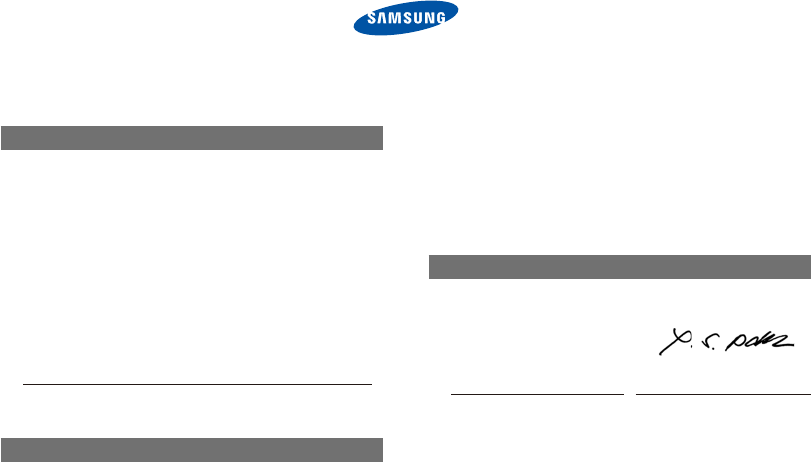
Appendixes
129
Declaration of Conformity
EN 55022:2006 EN 301 489-1 v1.8.1:2008
EN 300 328-1 v1.7.1 EN 301 489-17 v2.1.1:2009
and the Eco-Design Directive (2009/125/EC) implemented by
Regulation (EC) No 278/2009 for external power supplies
Representative in the EU
Samsung Electronics Euro QA Lab.
Blackbushe Business Park
Saxony Way, Yateley, Hampshire
GU46 6GG, UK
May 31, 2010
(Place and date of issue)
Yong Sang Park / S. Manager
(Name and signature of authorized person)
Product details
For the following
Product : DIGITAL CAMERA
Model(s) : SAMSUNG SH100
Manufactured at:
Manufacturer: SAMSUNG ELECTRONICS CO., LTD.
416, Maetan-3dong, Yeongtong-gu, Suwon-City,
Gyeonggi-do, 443-742, Korea
Factory: TianJin Samsung Opto-Electronics Co., Ltd.
No.9 ZhangHeng Street, Micro-Electronic Industrial Park,
JinGang Road, Tianjin, China. 300385
(Factories name and address)
Declaration & Applicable standards
We hereby declare, that the product above is in compliance
with the essential requirements of the R&TTE Directive (1999/5/
EC), the EMC Directive (2004/108/EC) and the LVD Directive
(2006/95/EC) by application of:
EN 60950-1:2006 EN 55024:1998+A1:2001+A2:2003

Appendixes
130
Entering text 97
Error messages 113
Exposure 54
F
Face detection
Blink detection 52
Face detection 50
Self-portrait 51
Smart face recognition 52
Smile shot 51
Facial brightness 33
Facial imperfections 33
Flash
Auto 45
Fill in 46
Off 45
Red-eye 46
Red-eye fix 46
Slow sync 46
D
Date and time 109
Deleting files 71
Digital Image Stabilization
(DIS) 27
Digital zoom 26
Disconnecting the device 87
Display brightness 109
Display type 24
DPOF 80
Dragging 21
E
Editing 76
Email
Address 95
Sending photo 100
Enlarging 72
B
Battery
Charging 117
Life 116
Specifications 116
Beauty Shot mode 33
Blink detection 52
Burst
Auto Exposure Bracket
(AEB) 59
Continuous 59
Motion capture 59
C
Camera shake 28
Capturing an image 74
Cleaning
Body 114
Display 114
Lens 114
A
ACB
in Playback mode 80
in Shooting mode 55
Adjusting
Brightness 80
Contrast
in Playback mode 80
in Shooting mode 63
Saturation
in Playback mode 80
in Shooting mode 63
Sharpness 62
AF Lamp 110
AF Sound 108
Allshare 101
Aperture 34
Auto Contrast Balance
(ACB) 55
Auto mode 25
Index

Appendixes
131
Playback button 18
Playback mode 65
Printing photos 89
Print order 80
Program mode 35
Protecting files 71
Q
Quick View 109
R
Recording
Video 36
Voice memo 39
Red-eye
in Playback mode 80
in Shooting mode 45
Reset 109
Resizing 76
Motion recognition
in Playback mode 66
in Shooting mode 23
Motion timer 44
Movie mode 36
Muting
Video 36
My Star
Ranking 68
Registering faces 53
N
Normal (AF) 47
O
One touch shooting 49
P
Photo quality 42
Photo styles
in Playback mode 77
in Shooting mode 60
I
Icons 20
Imprint 110
Intelli-studio 85
ISO speed 46
L
Light source
(White balance) 57
Long time shutter 34
M
Macro 47
Maintenance 114
Memory card
Capacity 115
microSD 115
Metering
Center 56
Multi 56
Spot 56
Focus area
Center AF 49
Multi AF 49
One touch shooting 49
Smart Touch AF 49
Focus distance
Auto macro 47
Macro 47
Format 109
Frame guide 34
Frame rate 36
Function description 108
G
Grid line 24, 108
H
Half-pressing 7
Index

Appendixes
132
Voice memo
Playing 74
Recording 39
Volume 108
W
Website
Accessing 98
Uploading photo 99
White balance 57
WLAN 92
Z
Zooming 26
T
Timer 43
Touch Calibration 19, 111
Touching 21
Transferring files
for Mac 88
for Windows 83
V
Video
Playing 73
Recording 36
Video Out 111
Viewing files
as thumbnails 70
on TV 82
Slide show 72
Smart album 69
Shutter speed 34
Slide show 72
Smart Album 69
Smart Auto mode 31
Smart crop 77
Smart face recognition 52
Smart filter effect
in Playback mode 78
in Shooting mode 61
Smart Scene
Detection mode 37
Smart Touch AF 48
Smile shot 51
Special effects
Add noise 79
Color filter 79
Elegant 79
Start image 108
Resolution
Photo 41
Video 42
RGB tone
in Playback mode 78
in Shooting mode 60
Rotating 76
S
Scene mode 32
Self-portrait 51
Service center 119
Settings
Accessing 107
Camera 109
Display 108
Sound 108
Shooting mode
Auto 25
Movie 36
Program 35
Scene 32
Smart Auto 31
Index
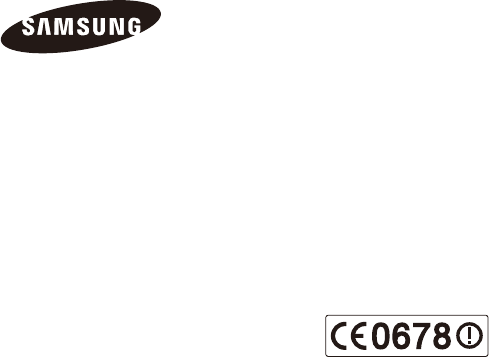
Please refer to the warranty that came with your product
or visit our website http://www.samsungimaging.com/ or
http://www.samsung.com/ for after-sales service or inquiries.